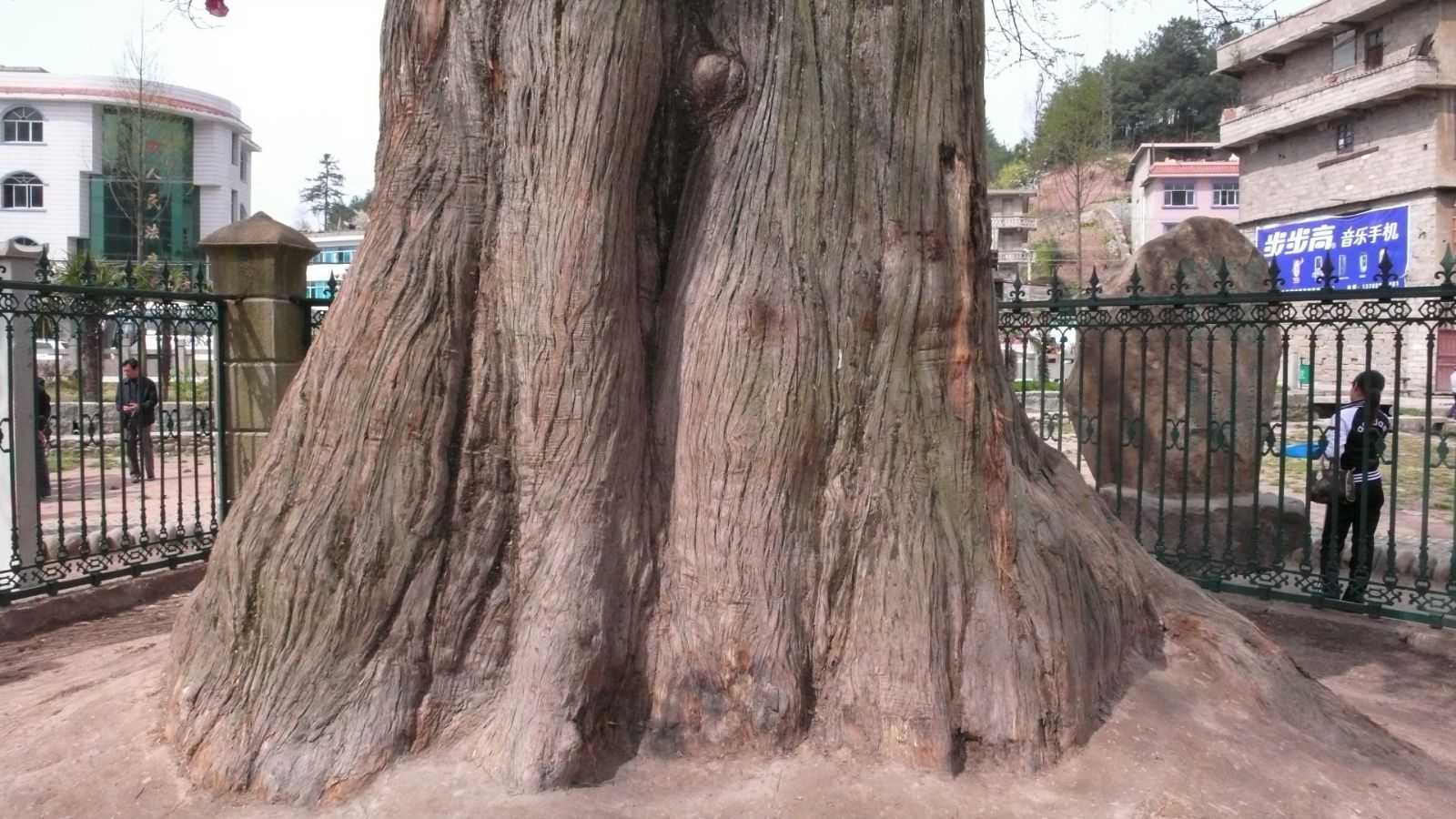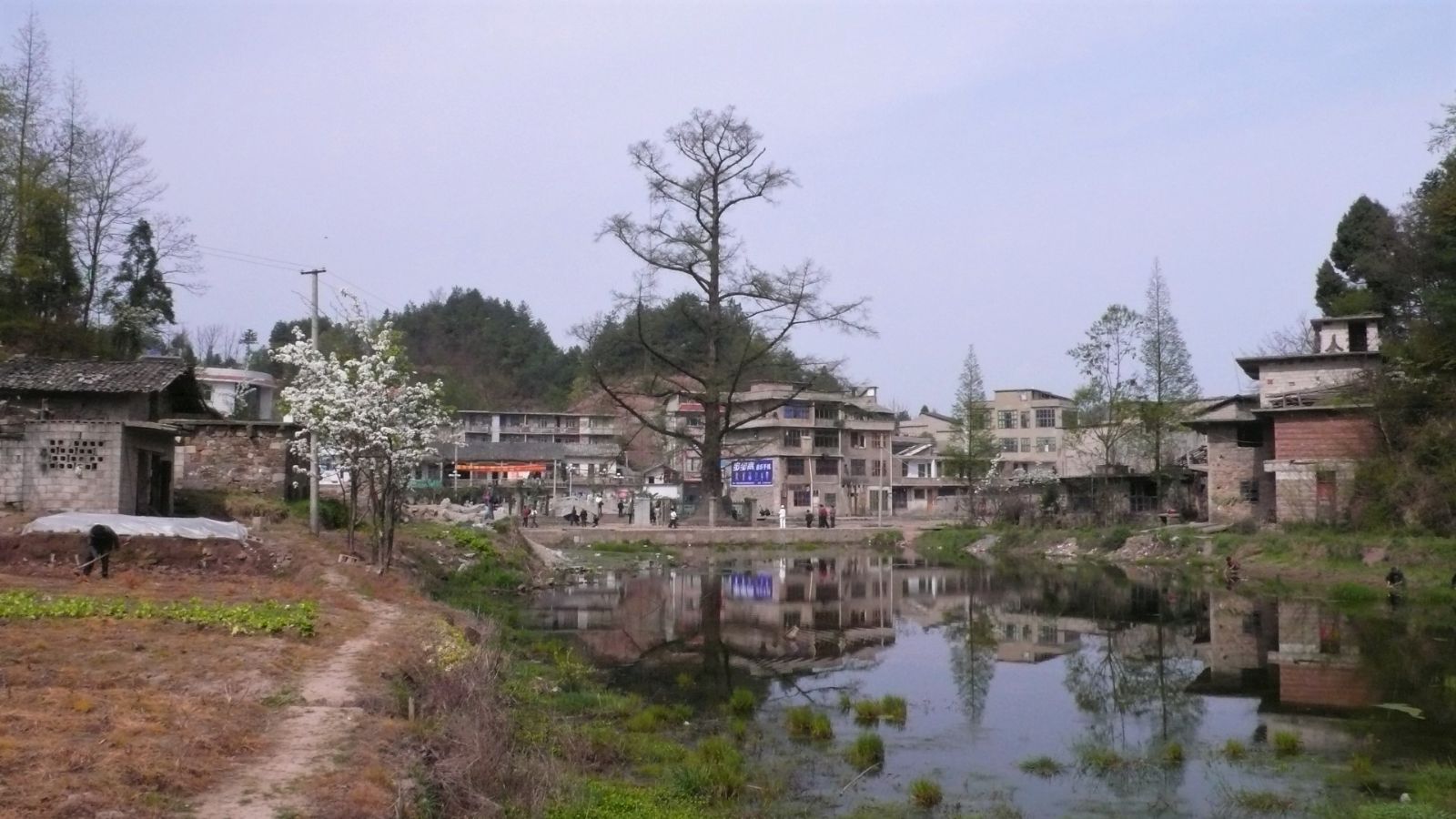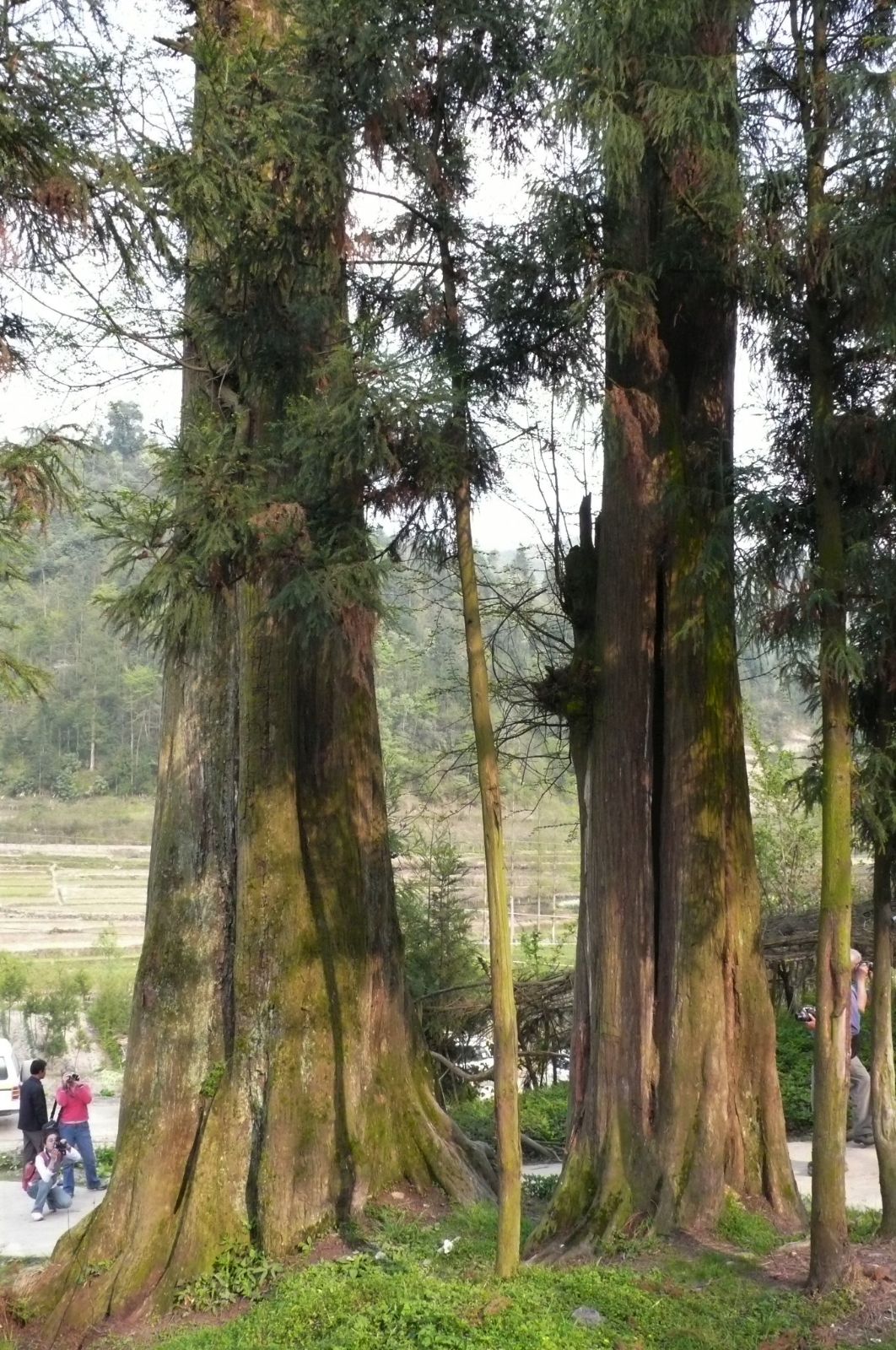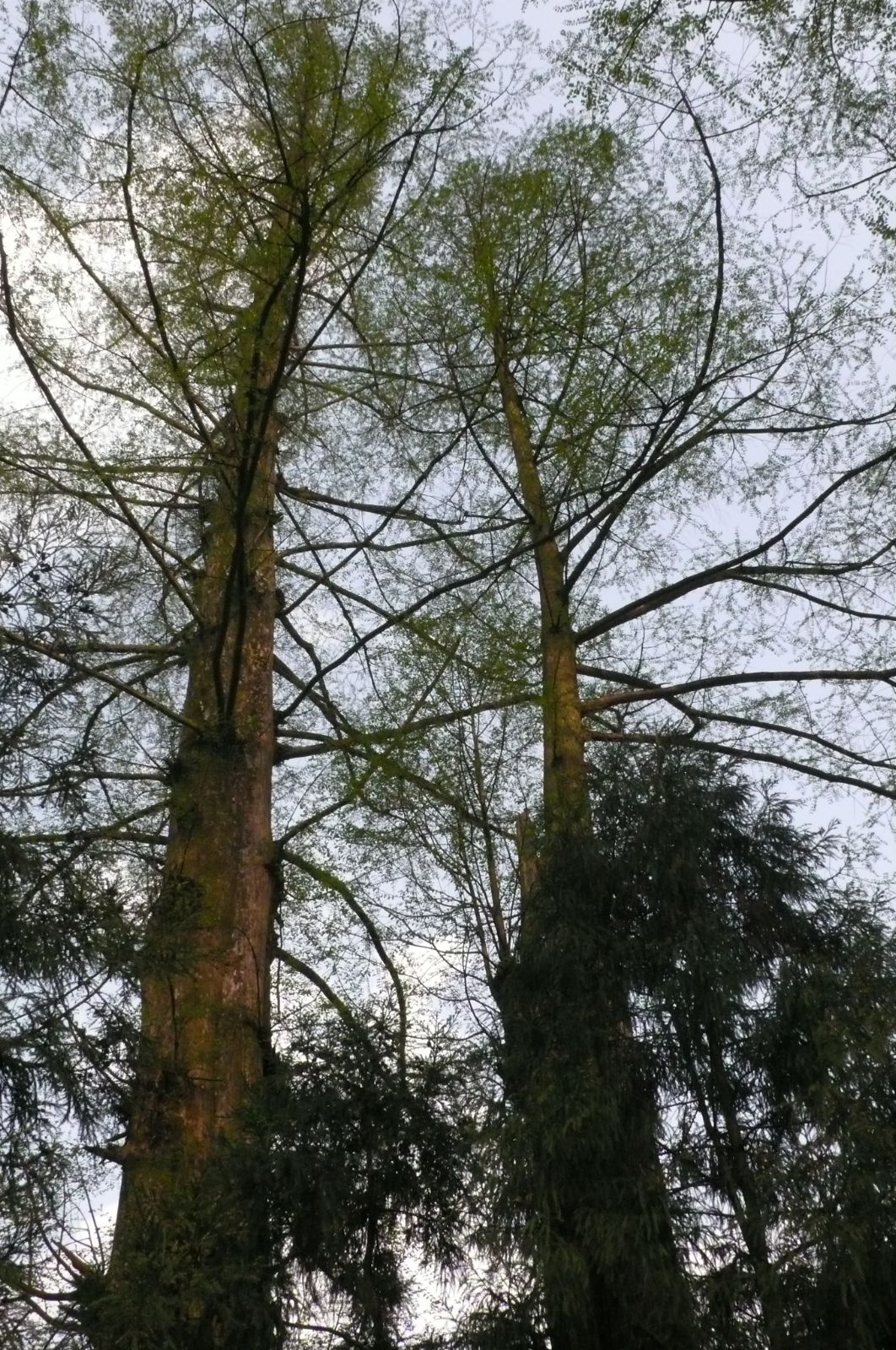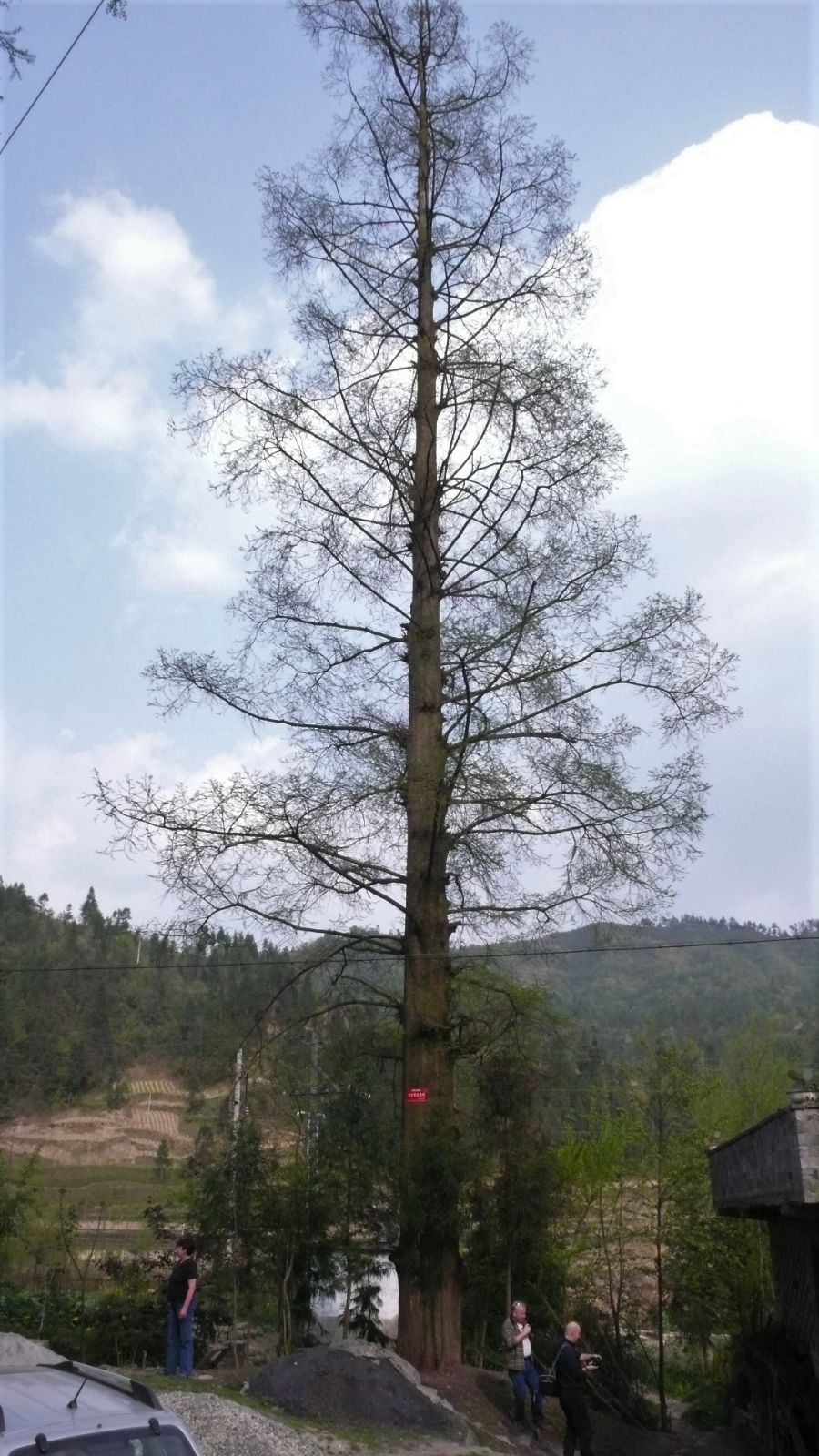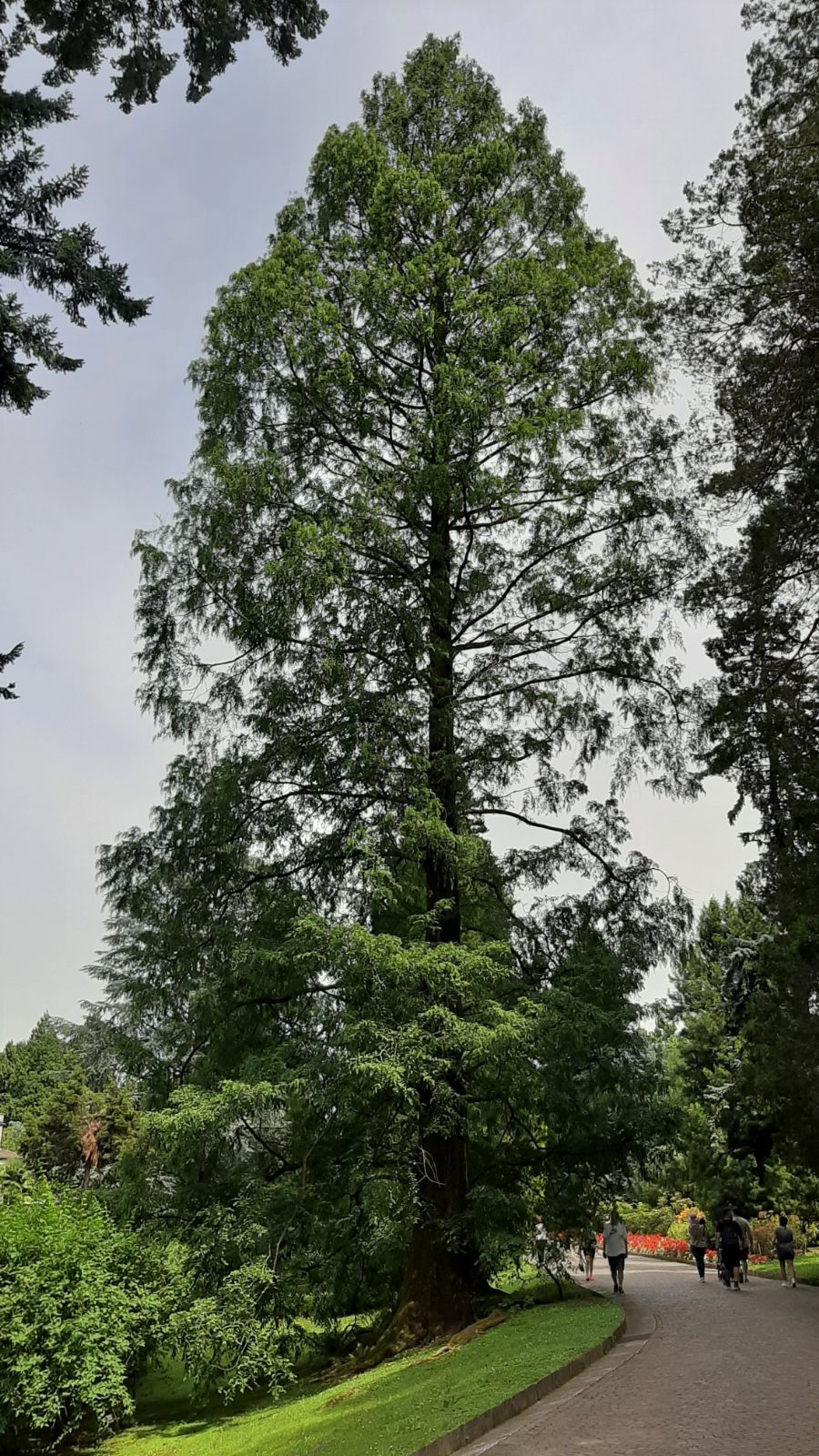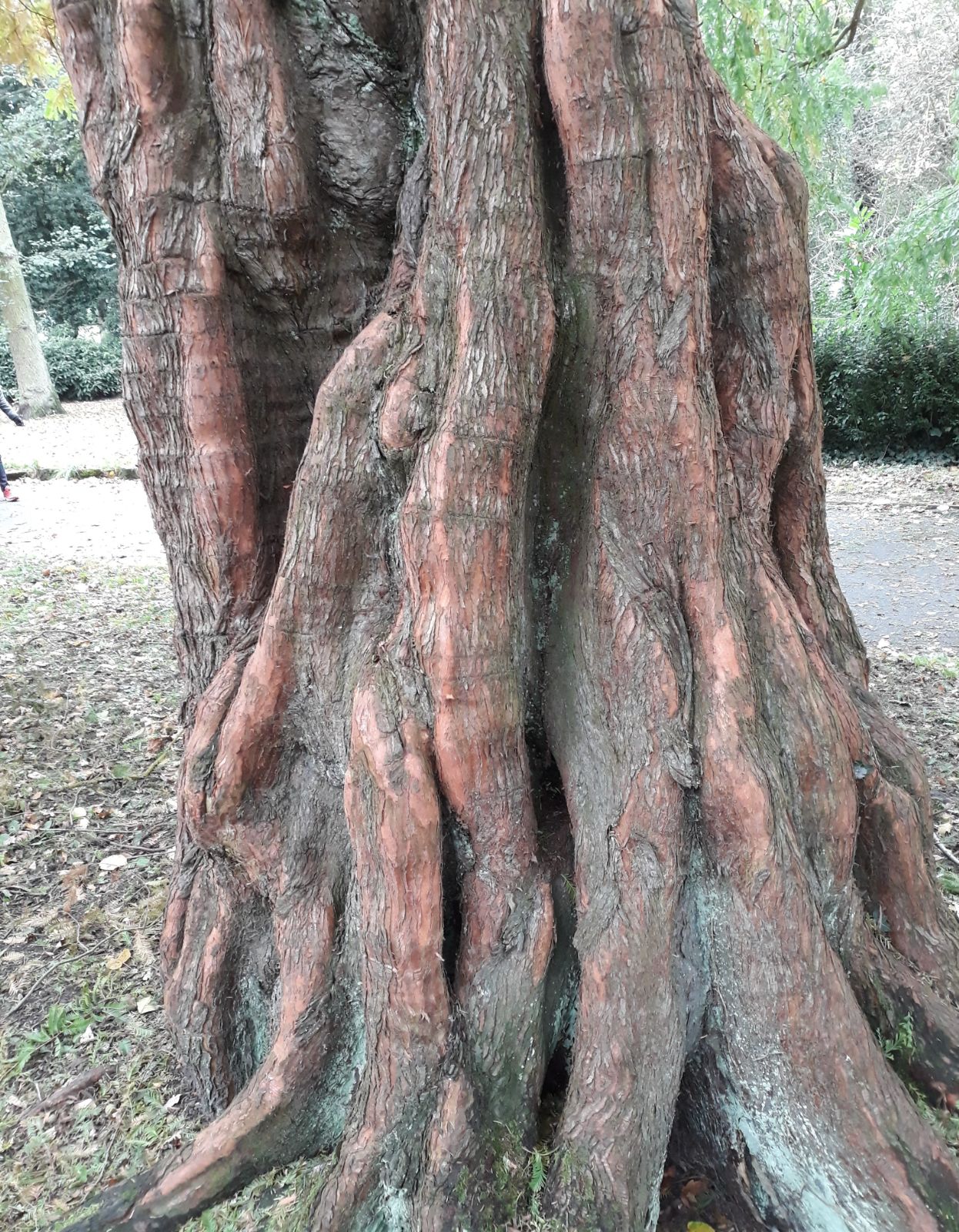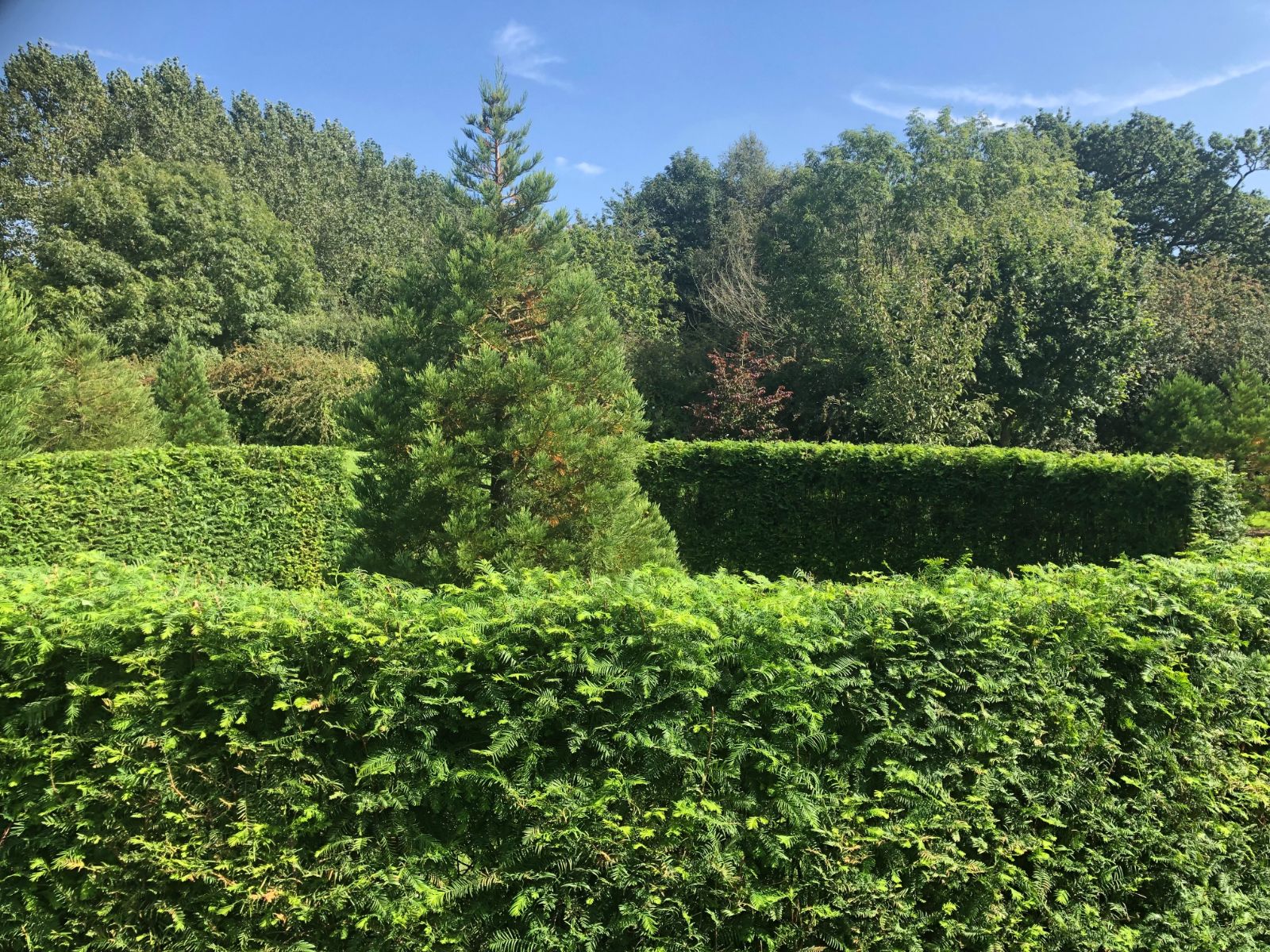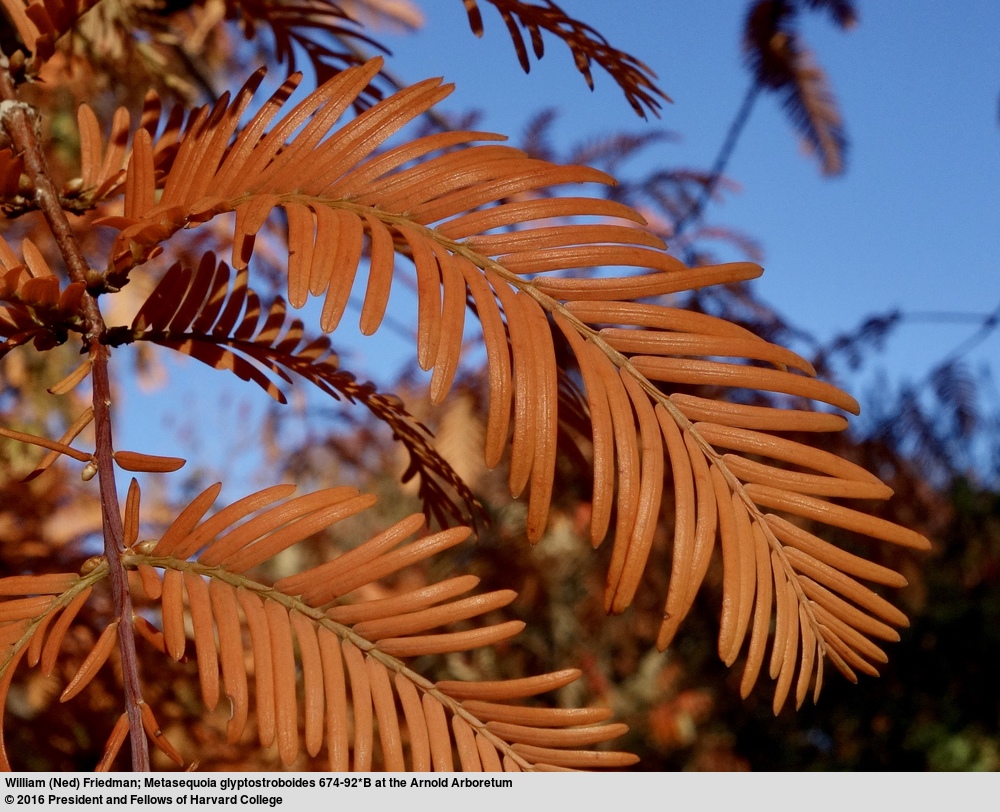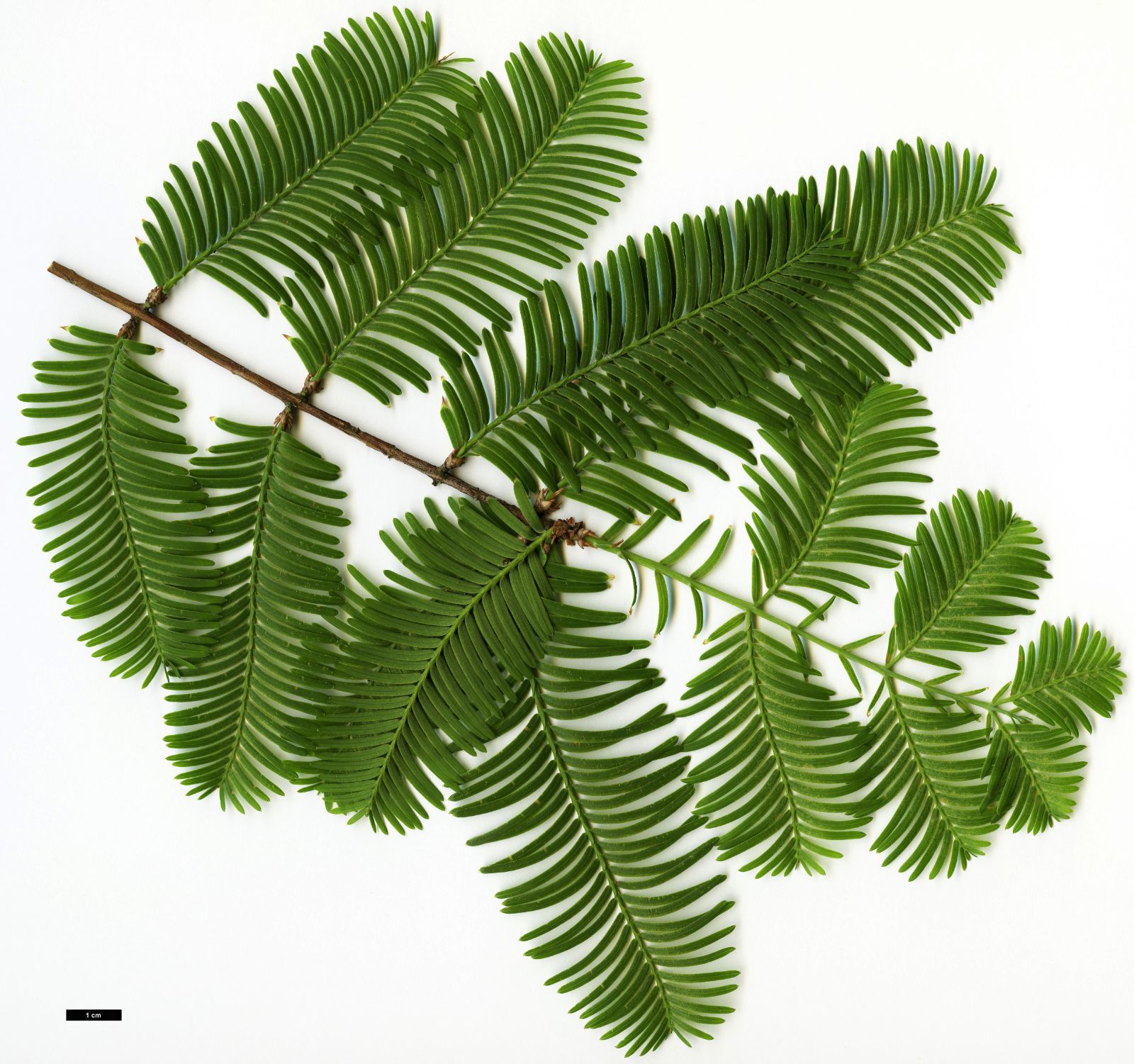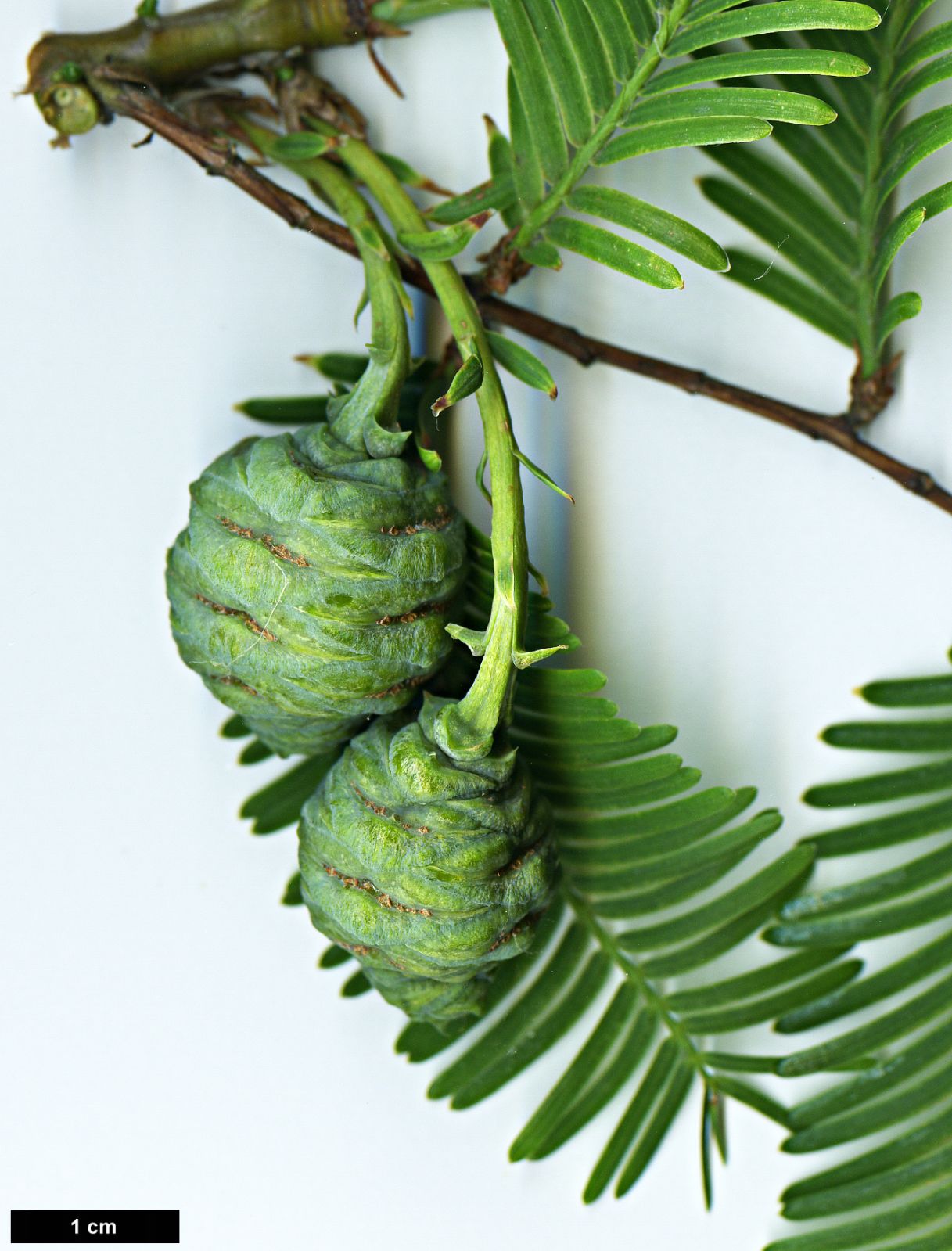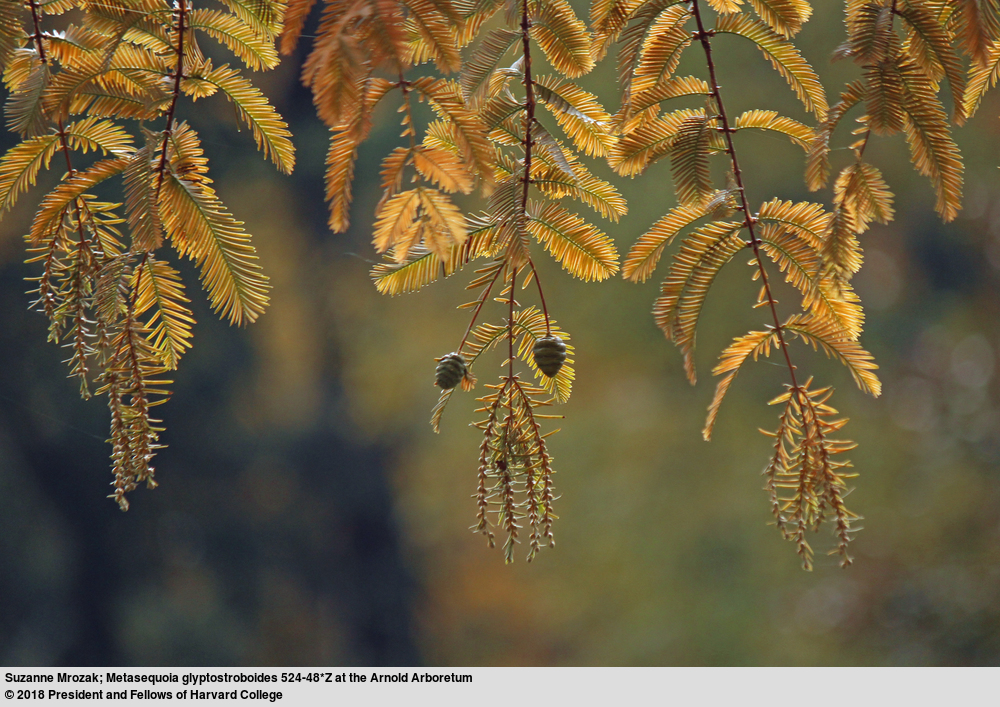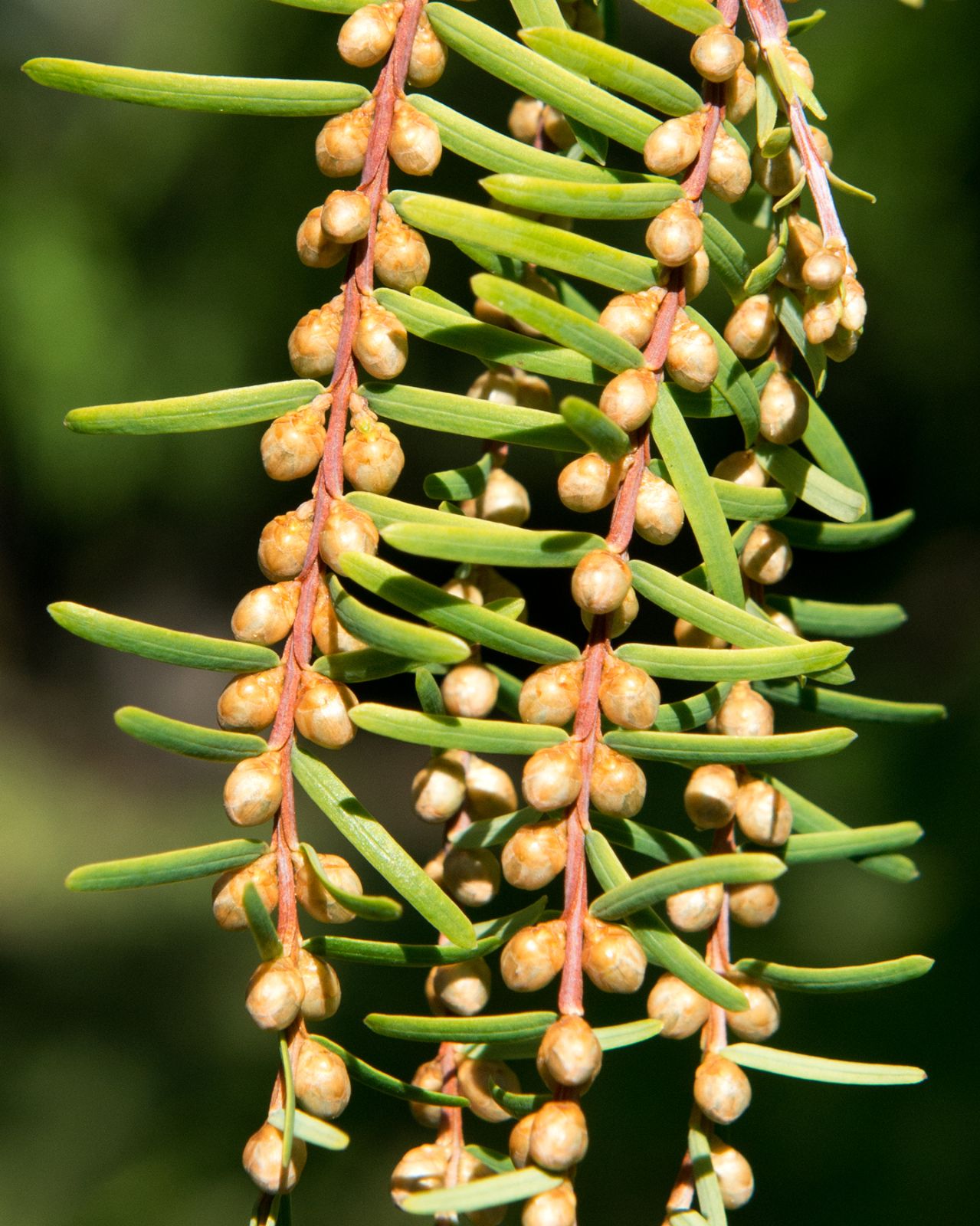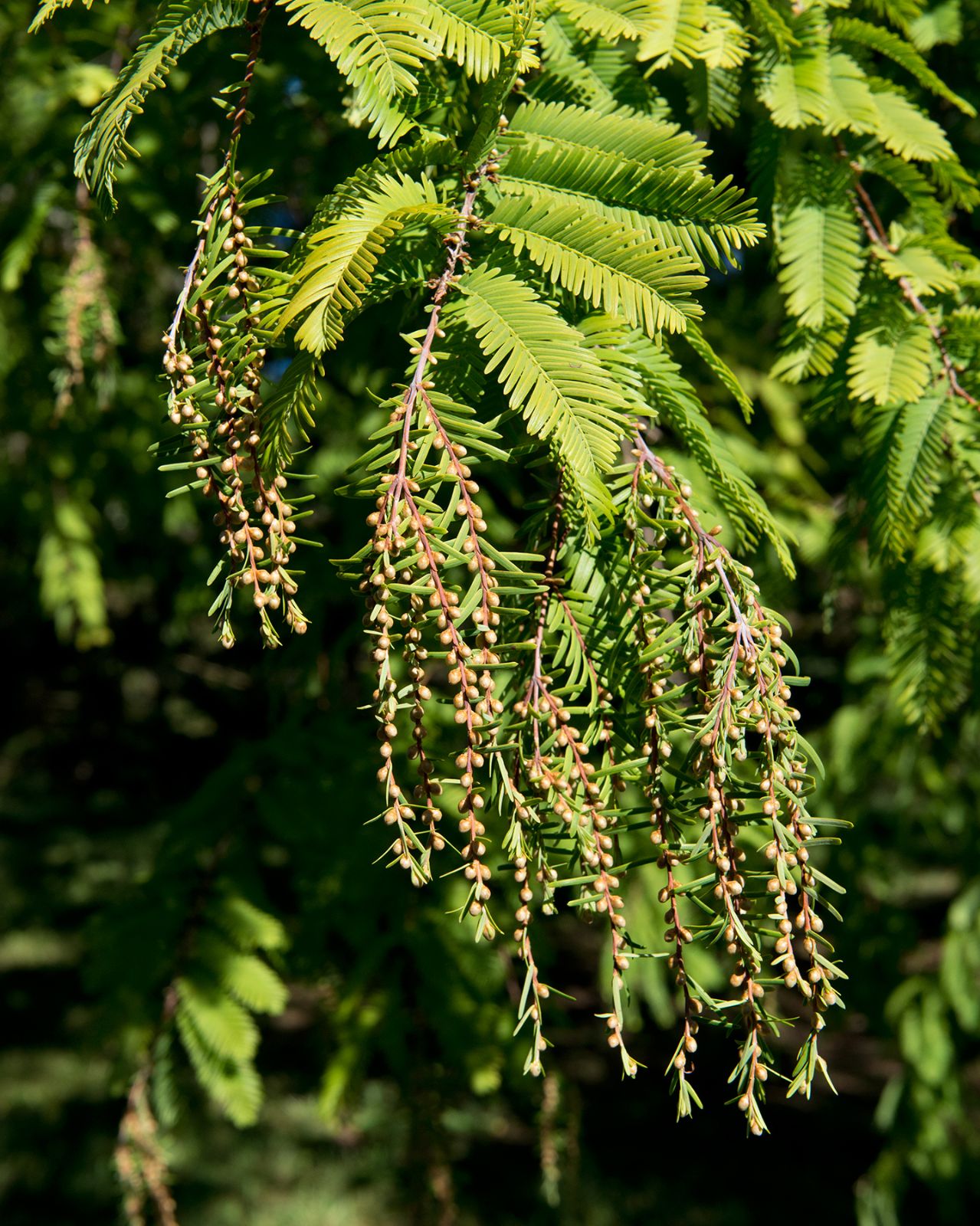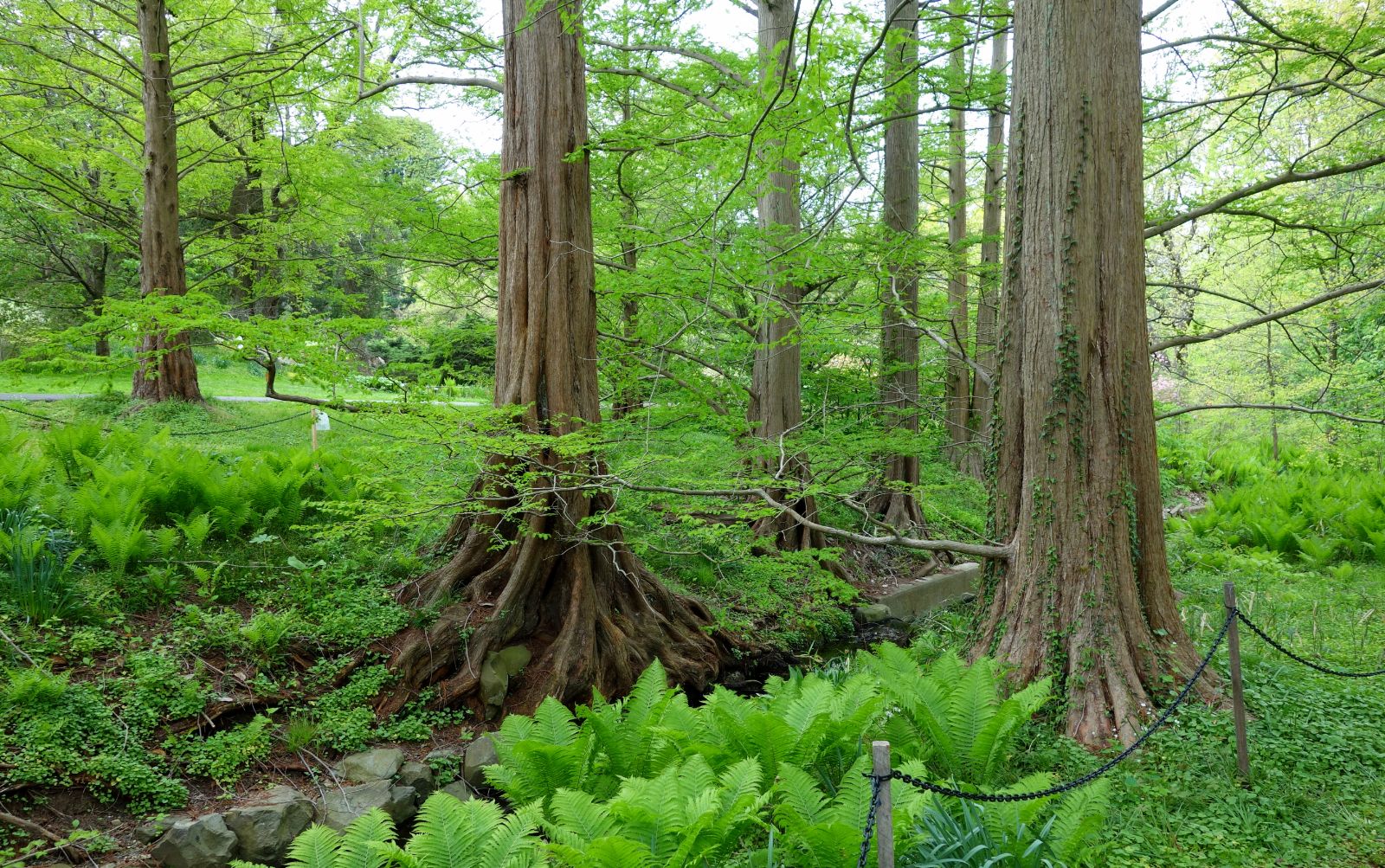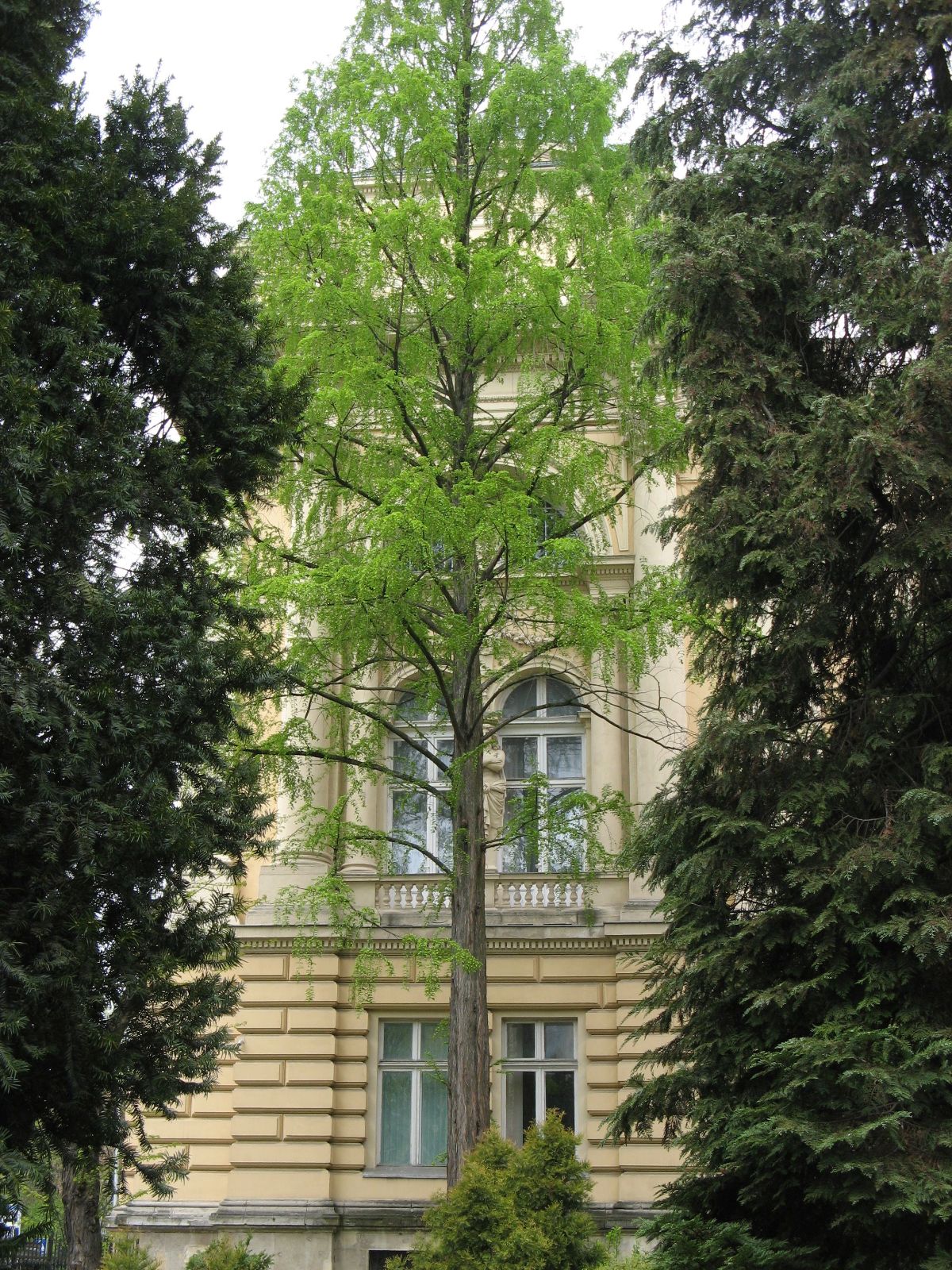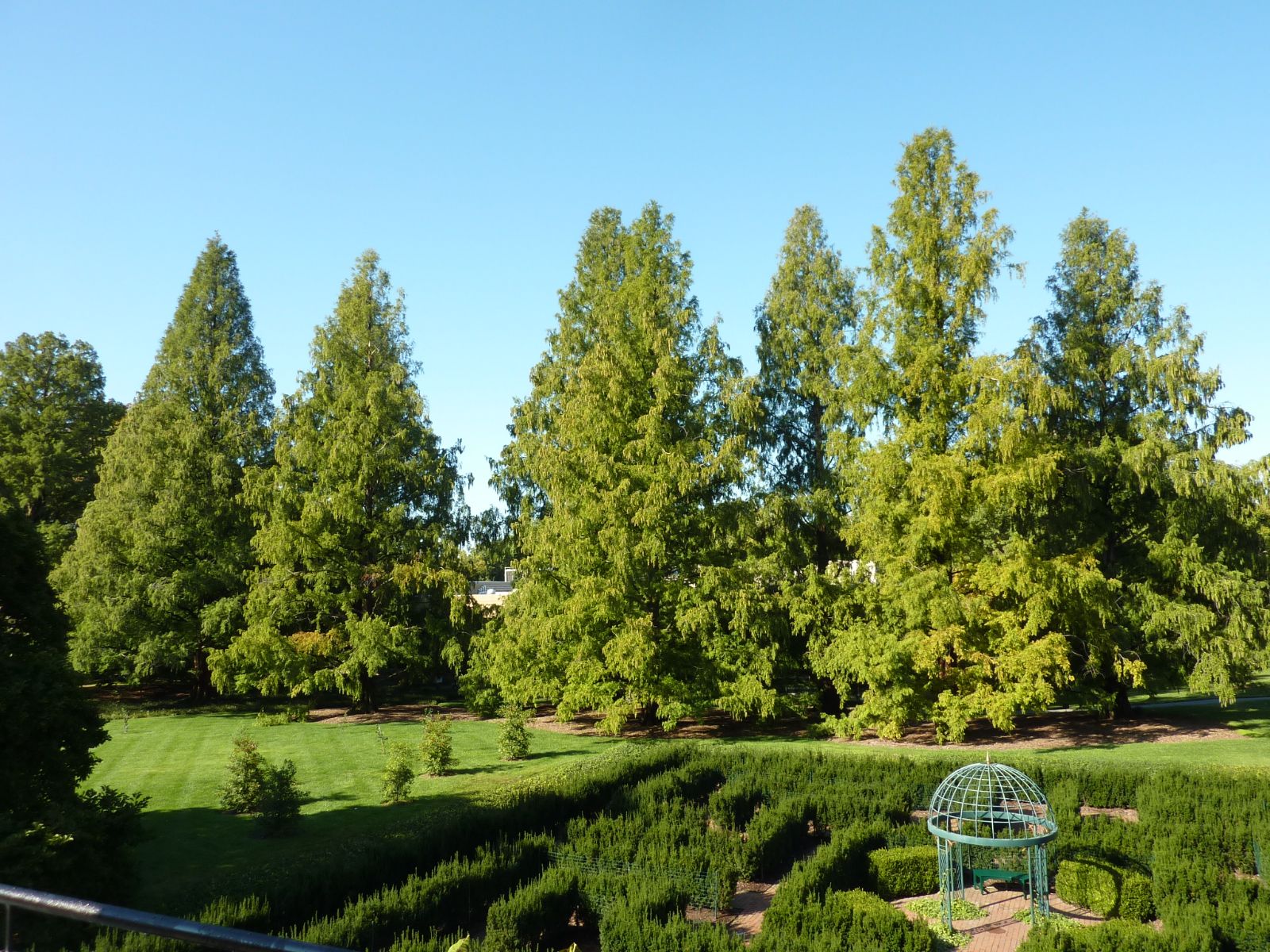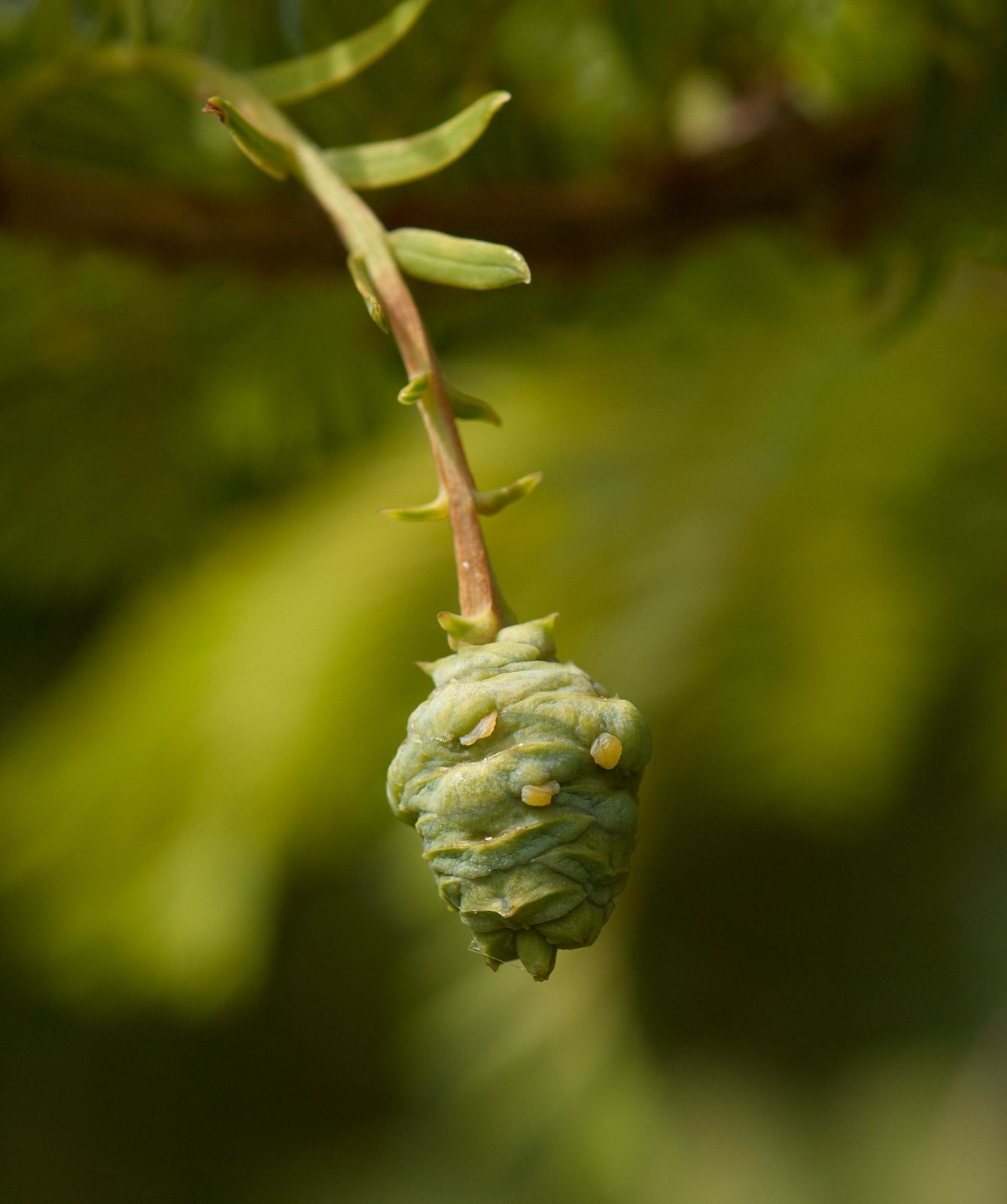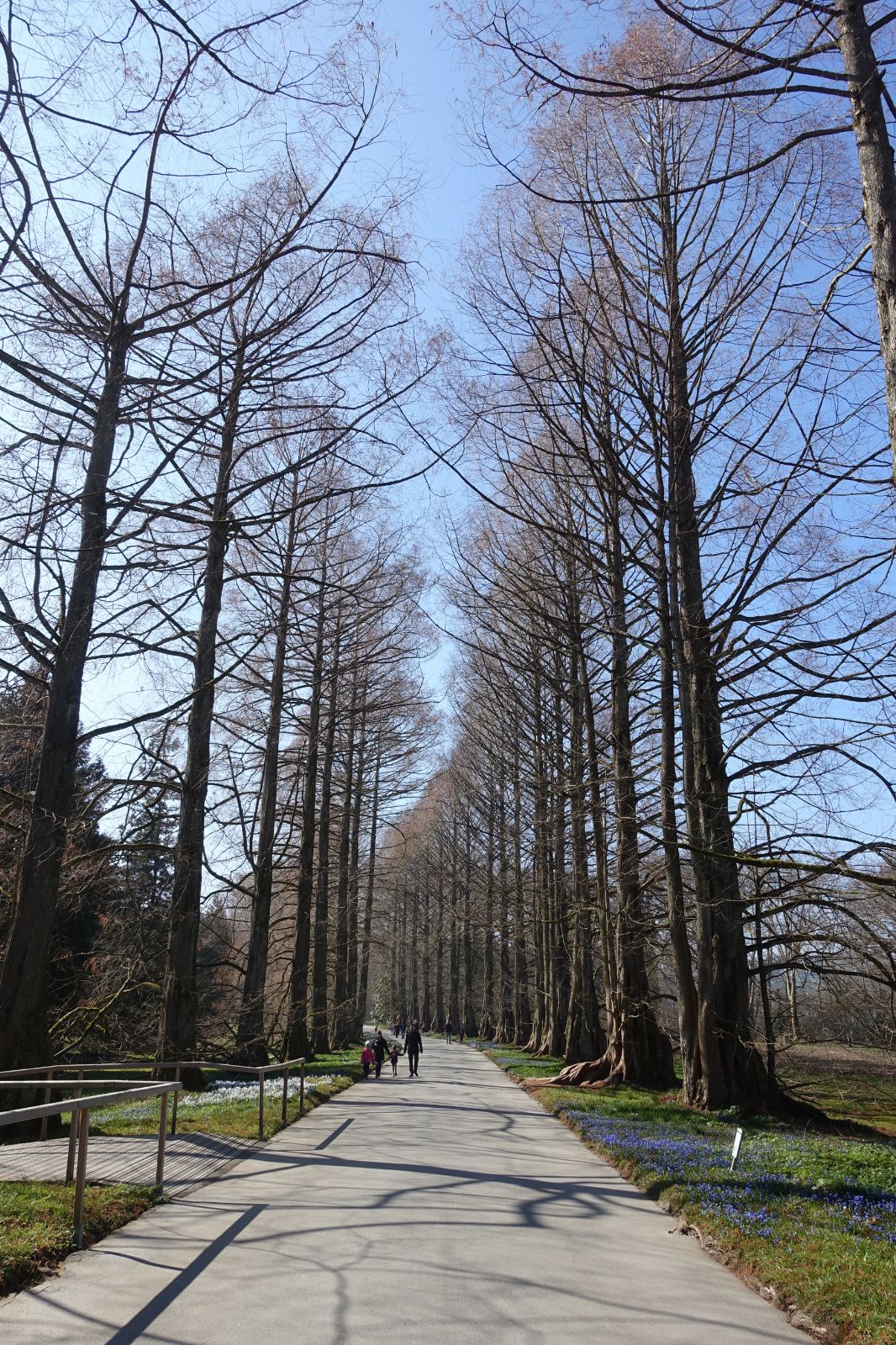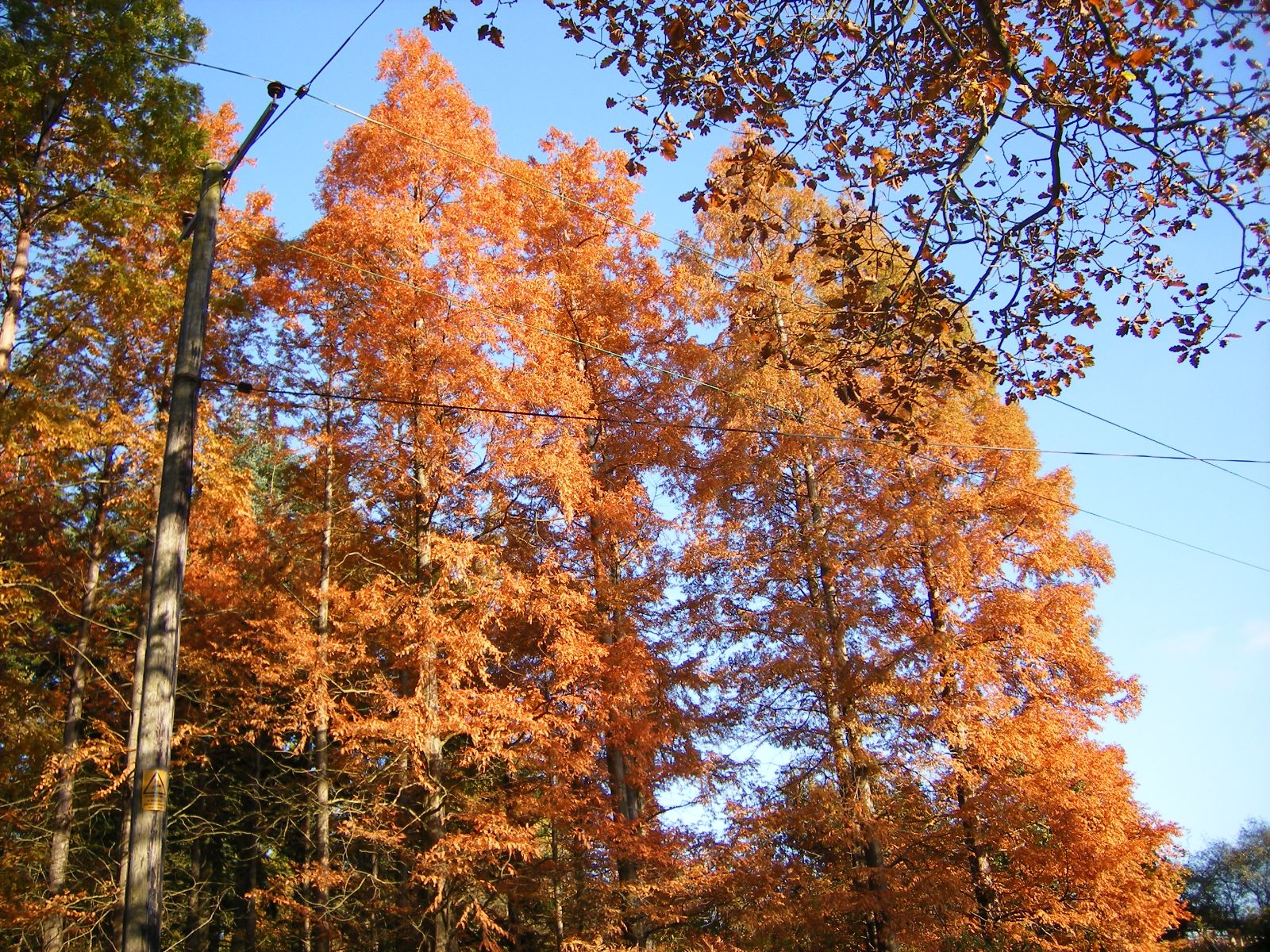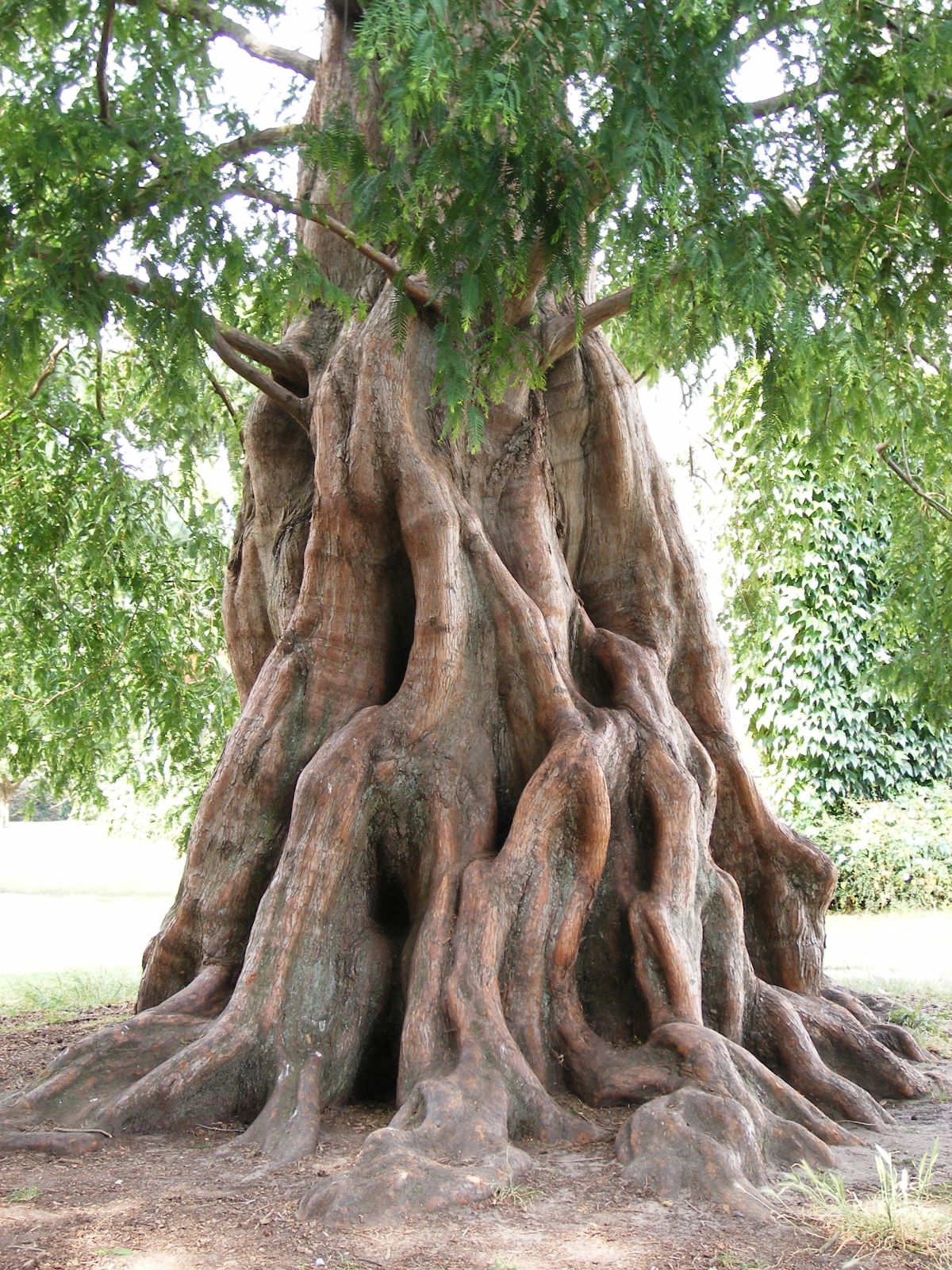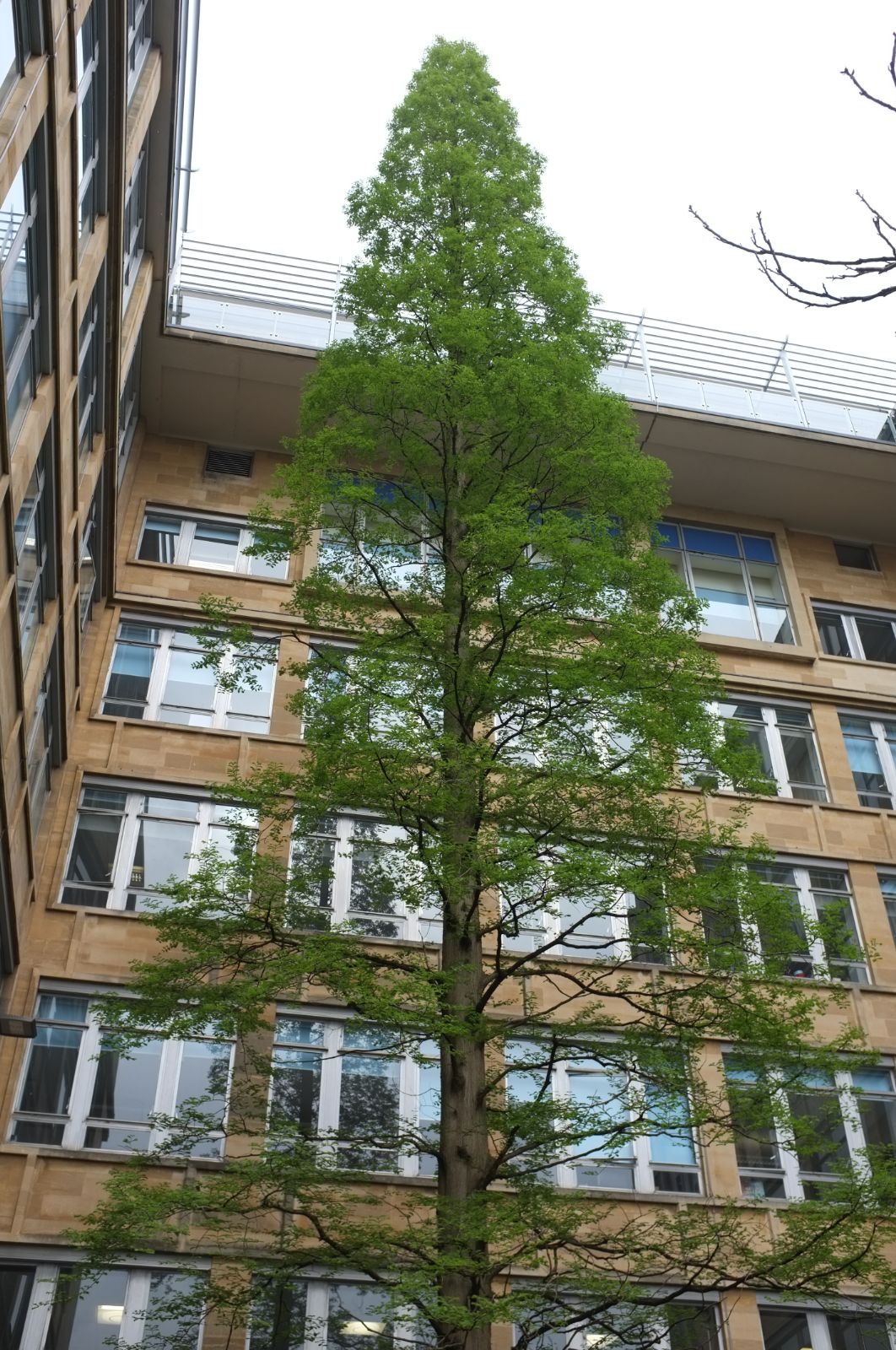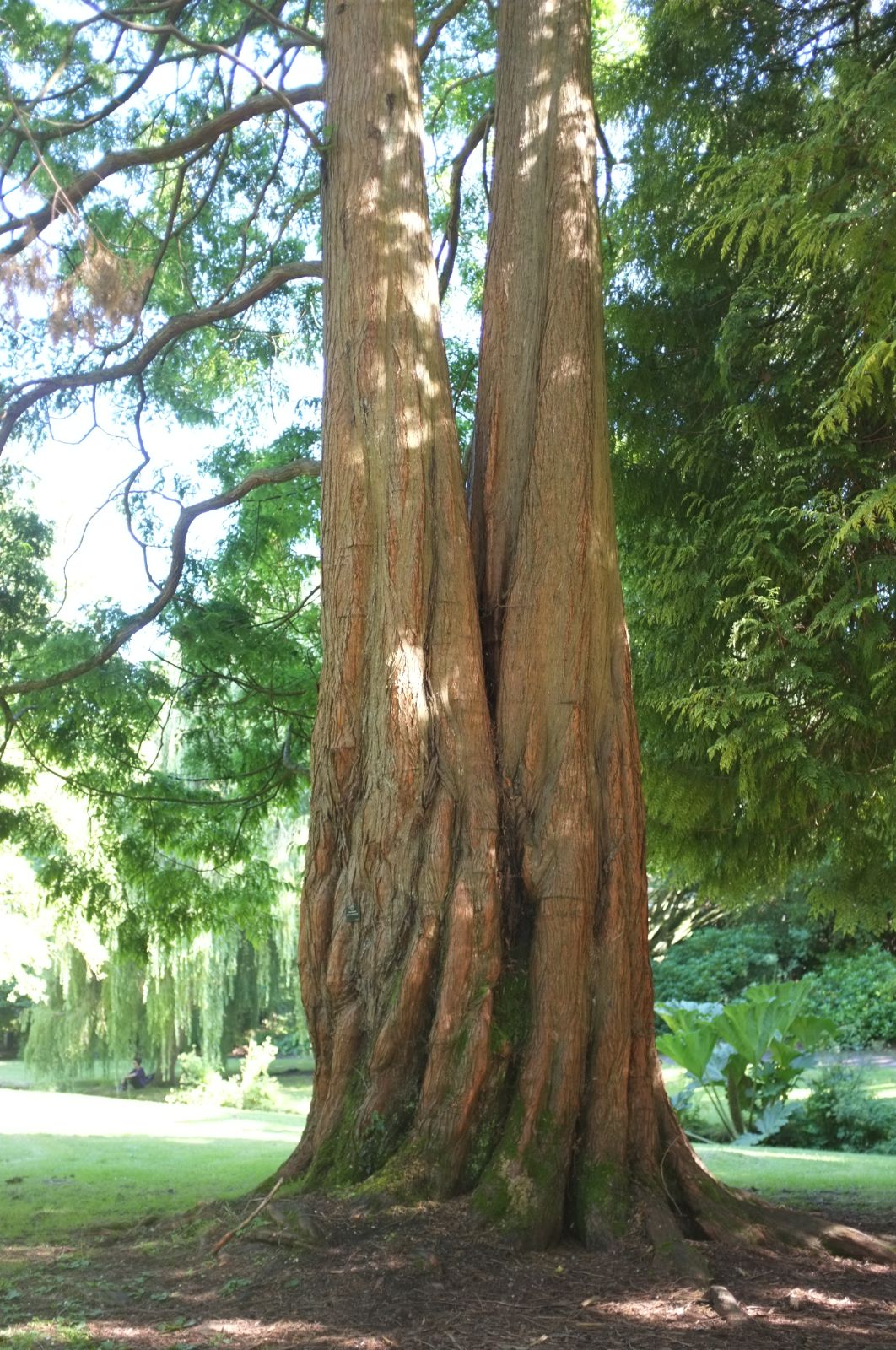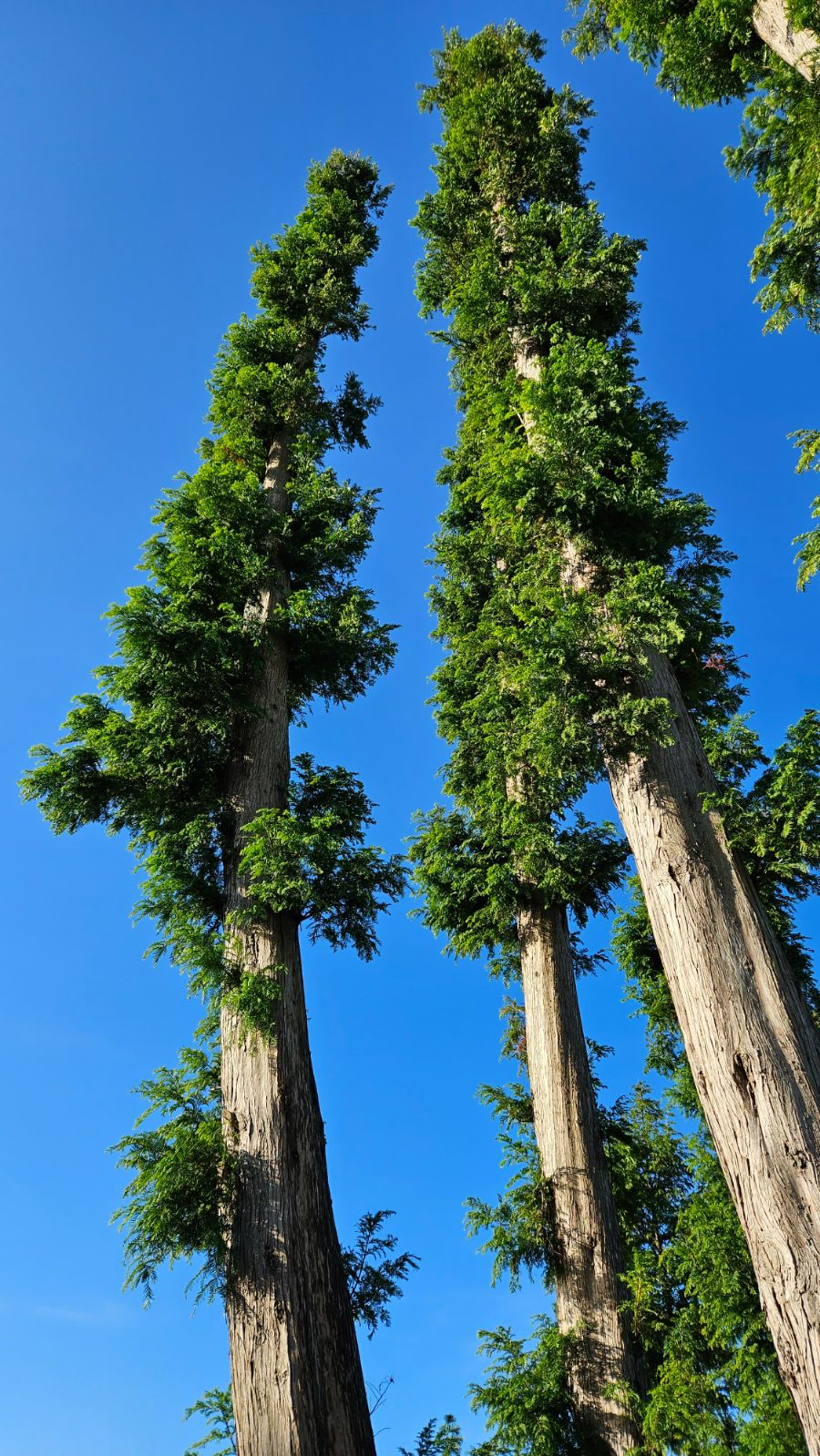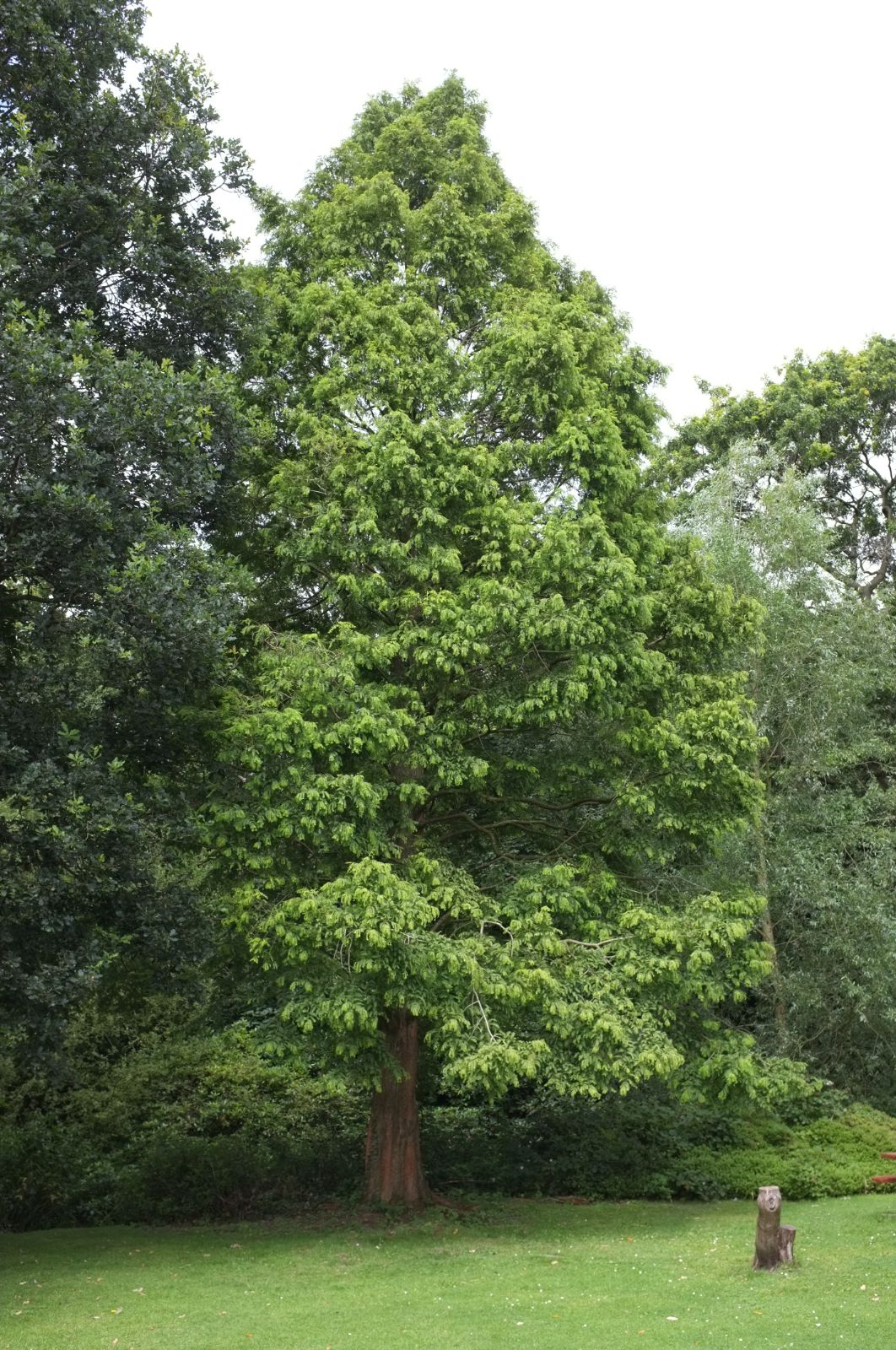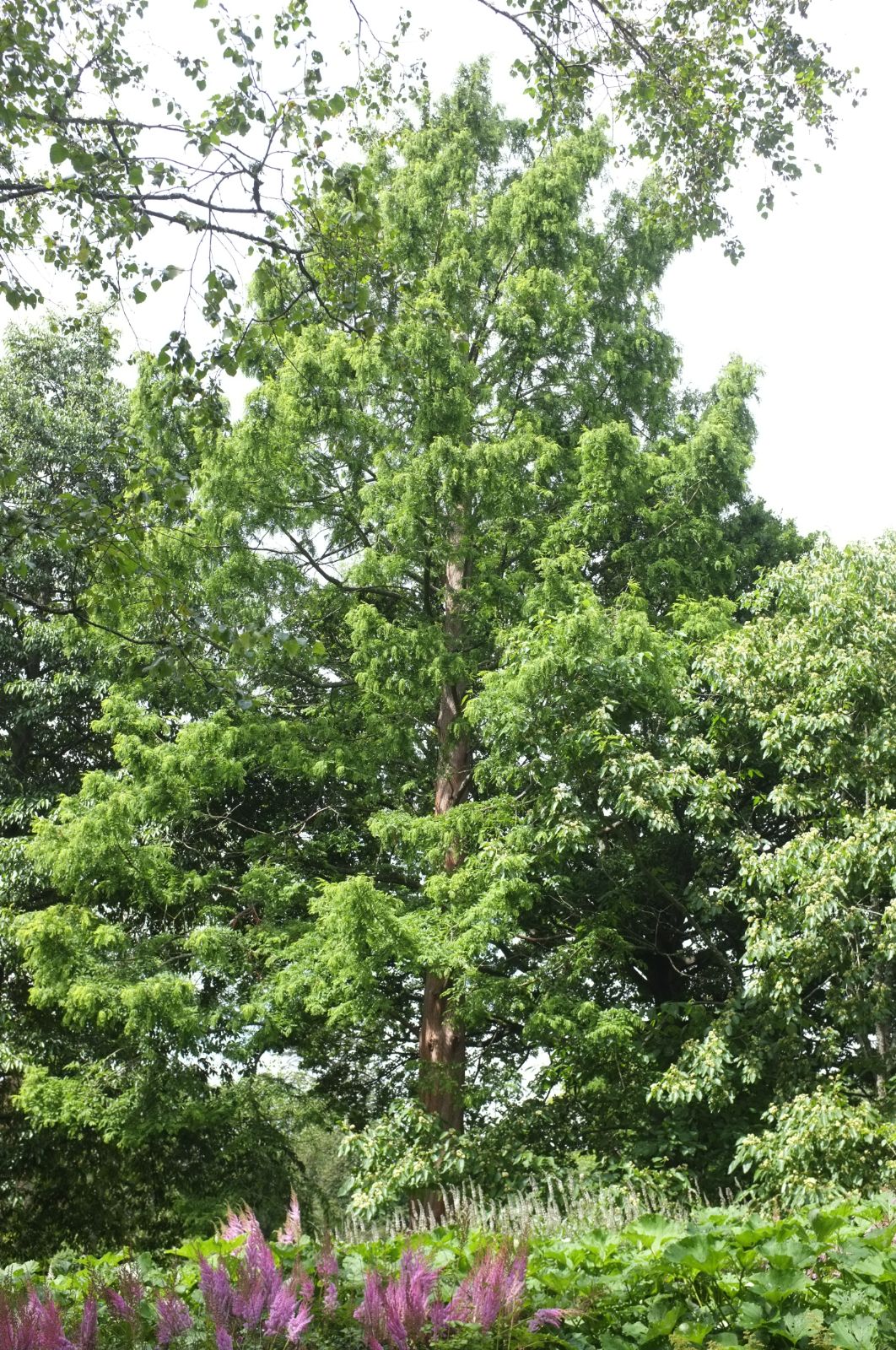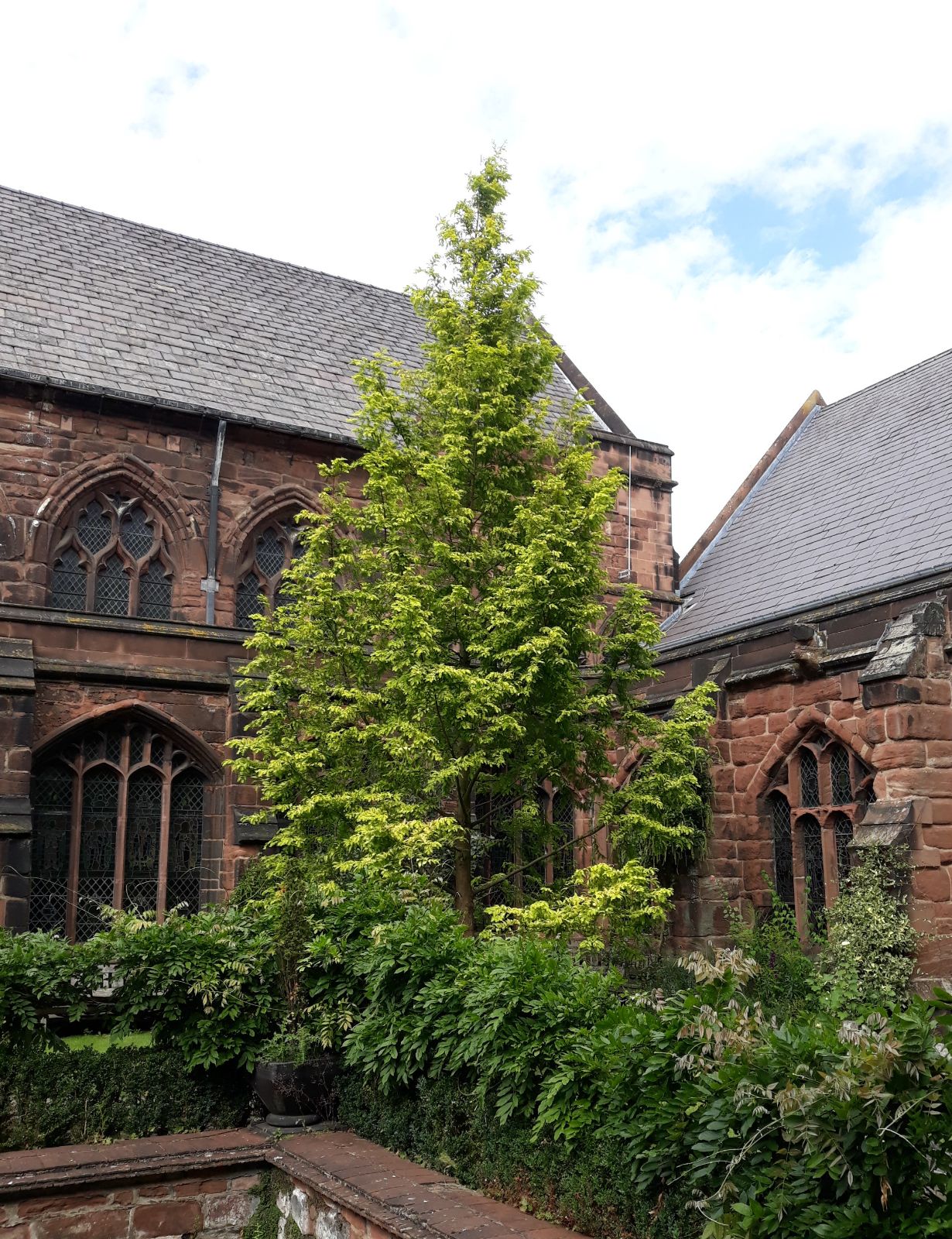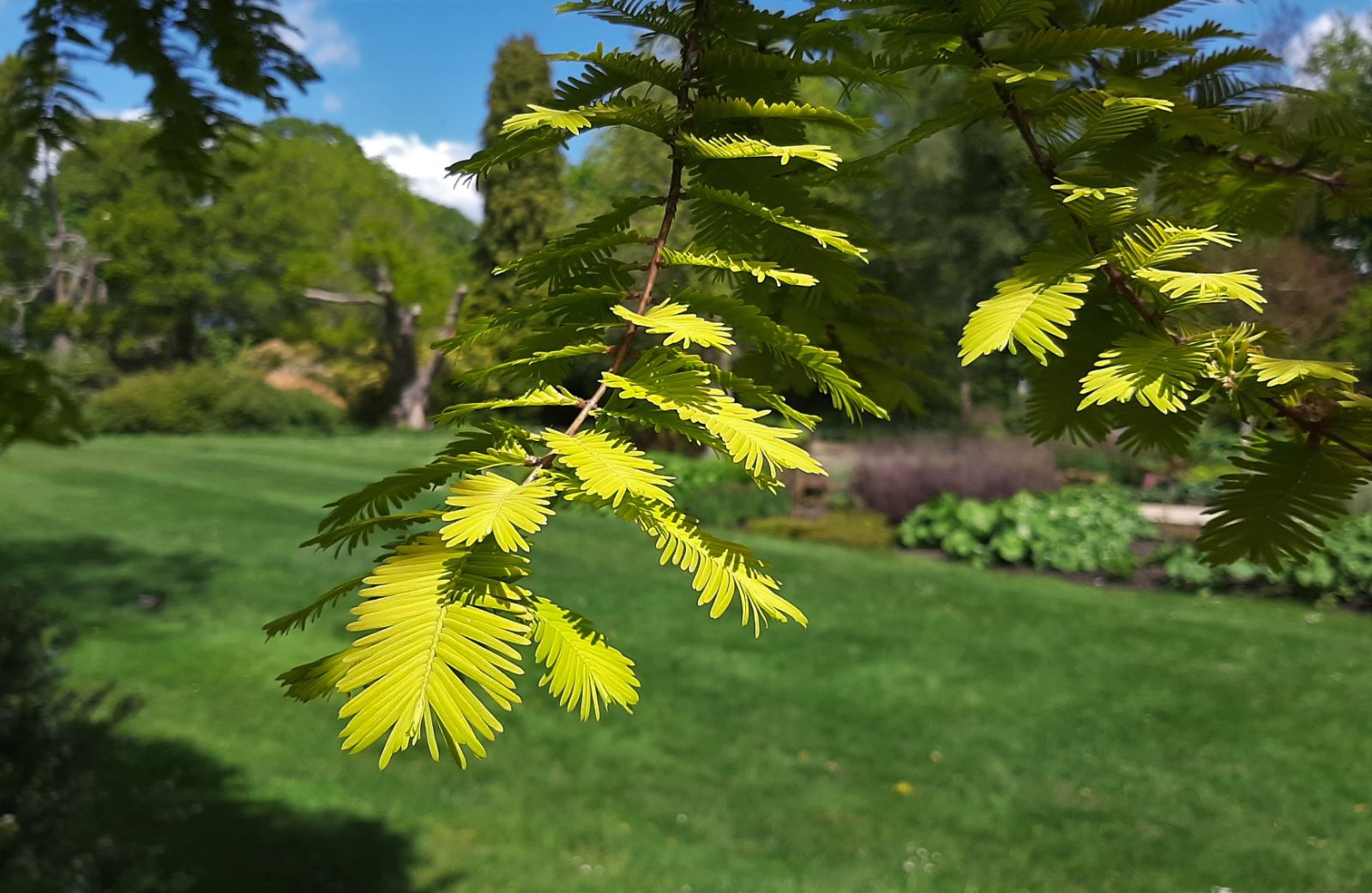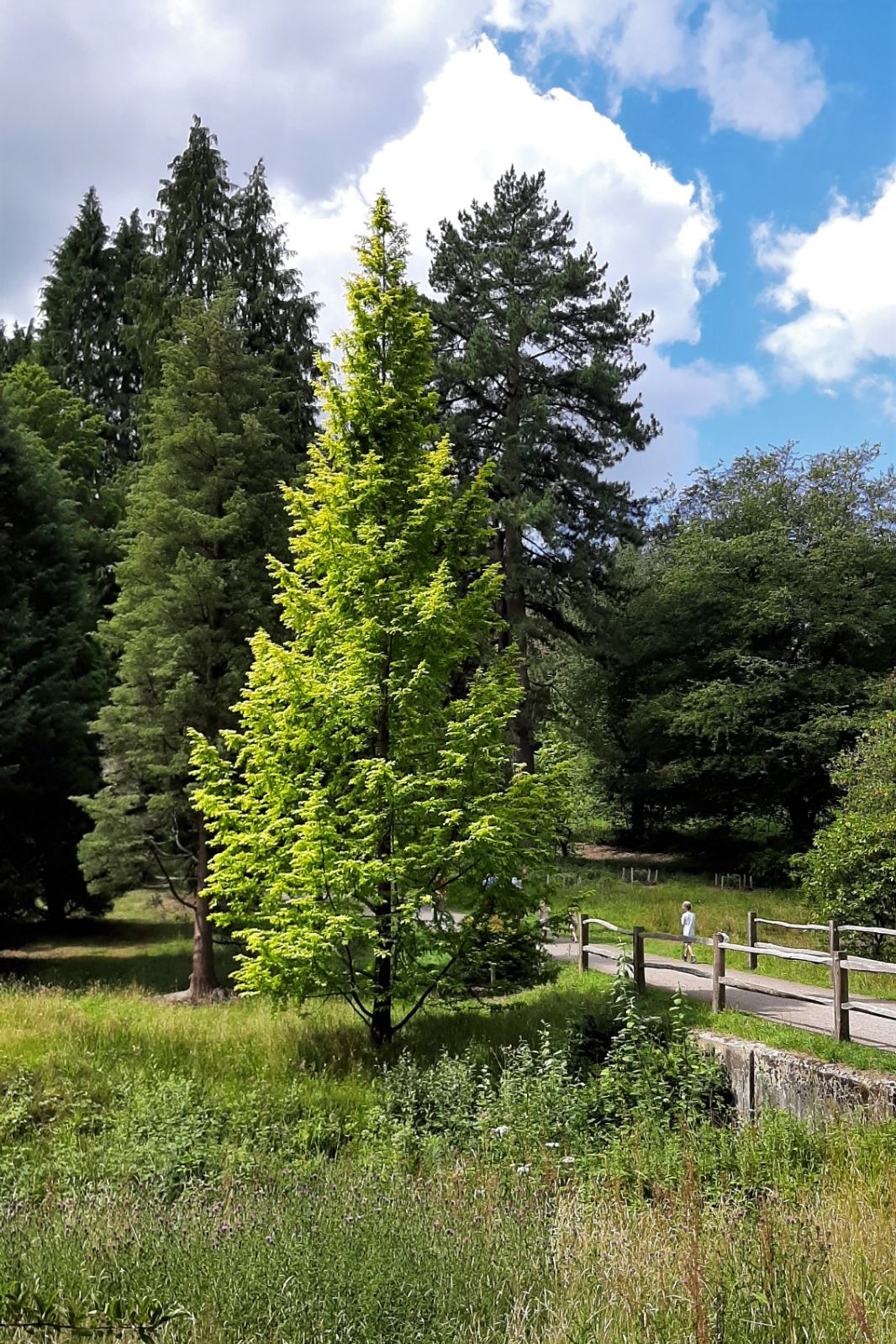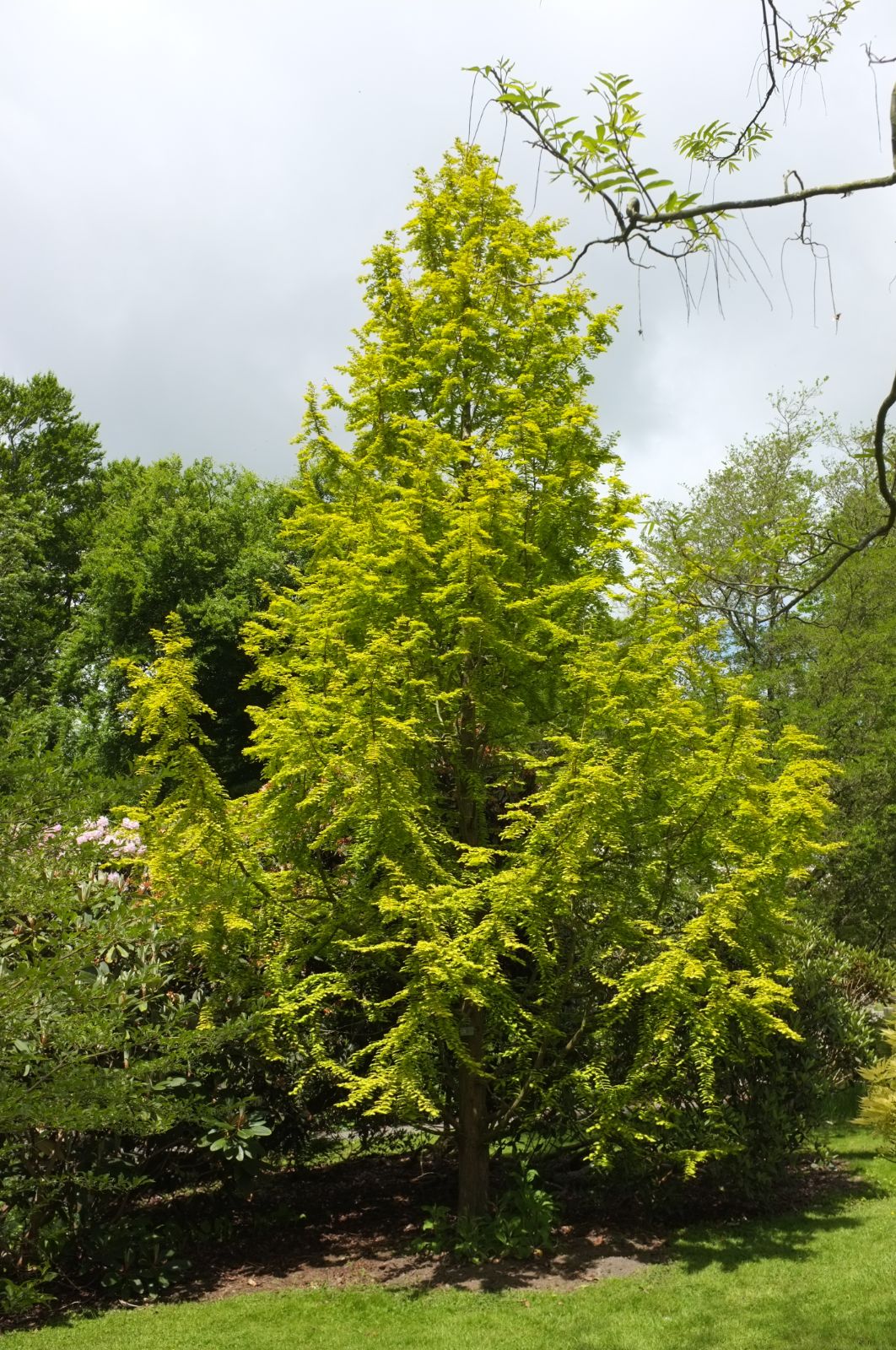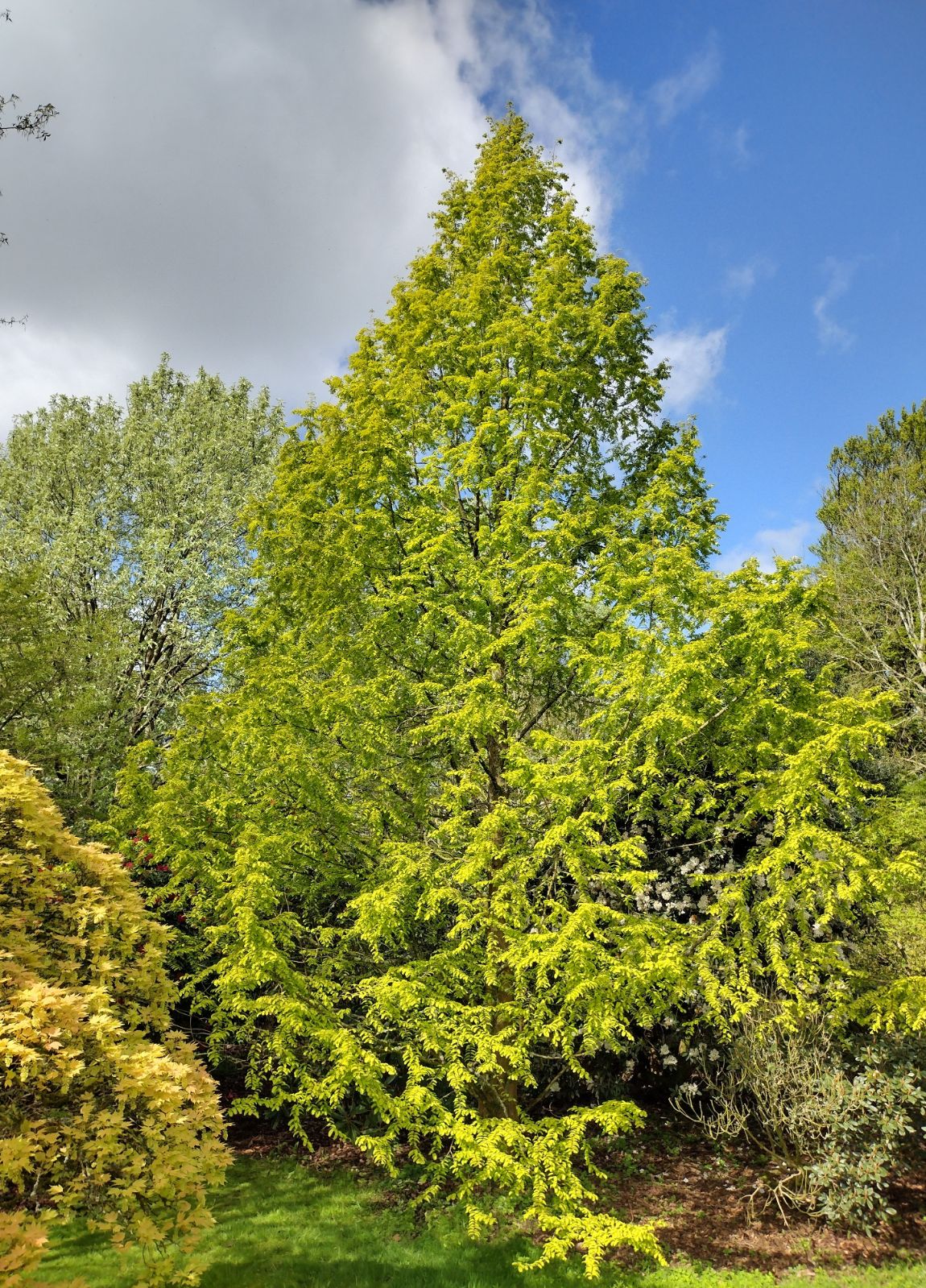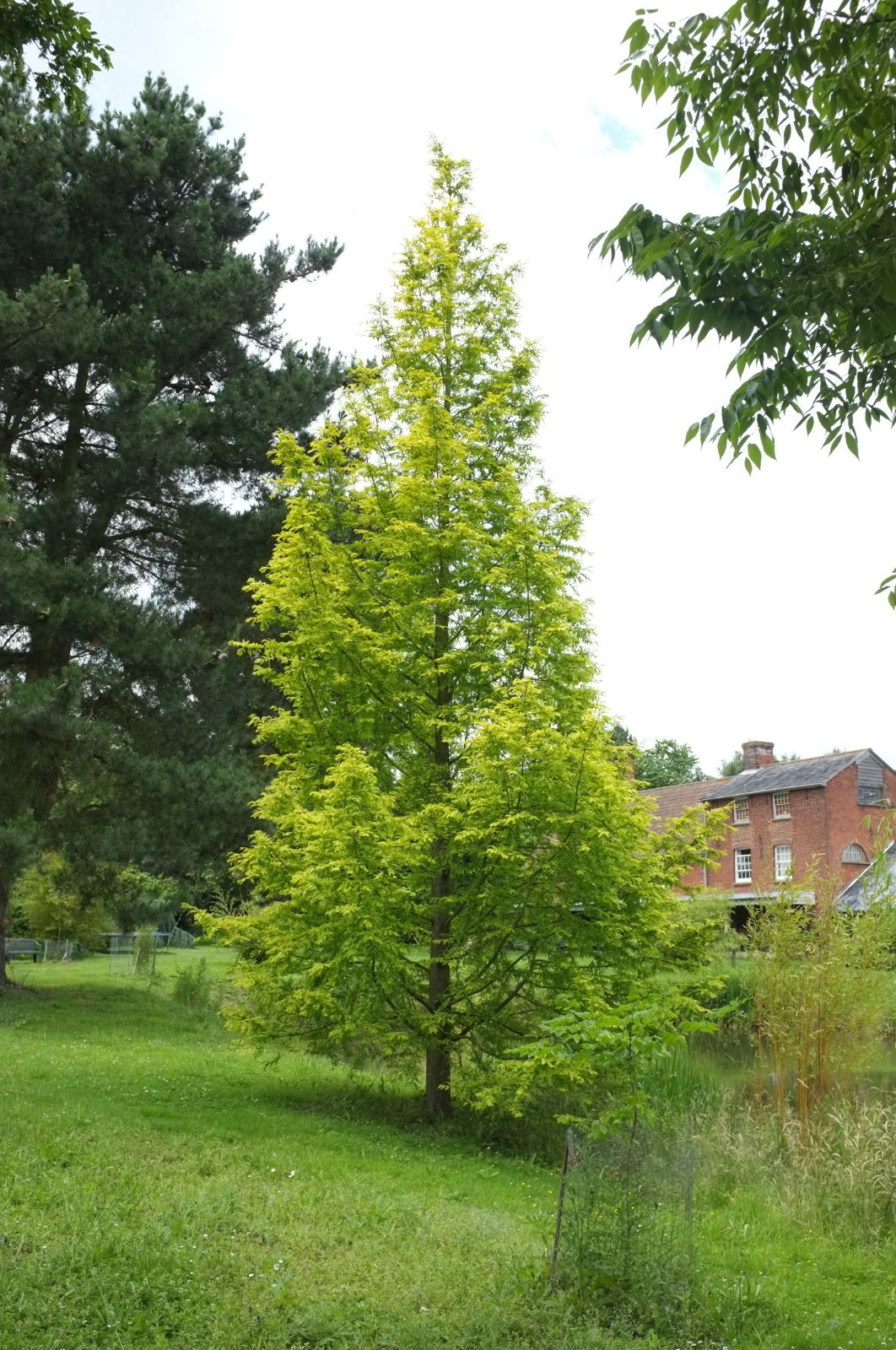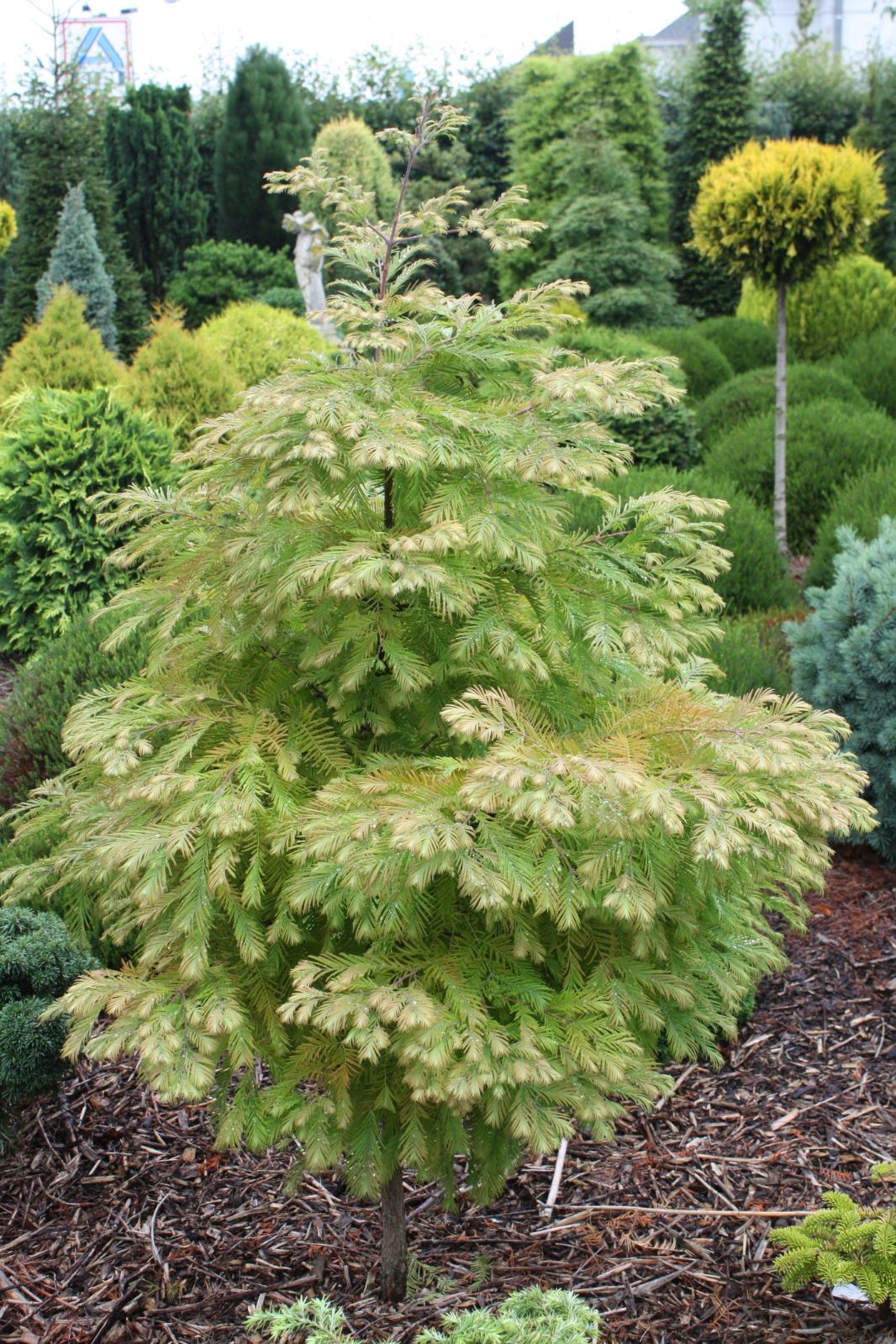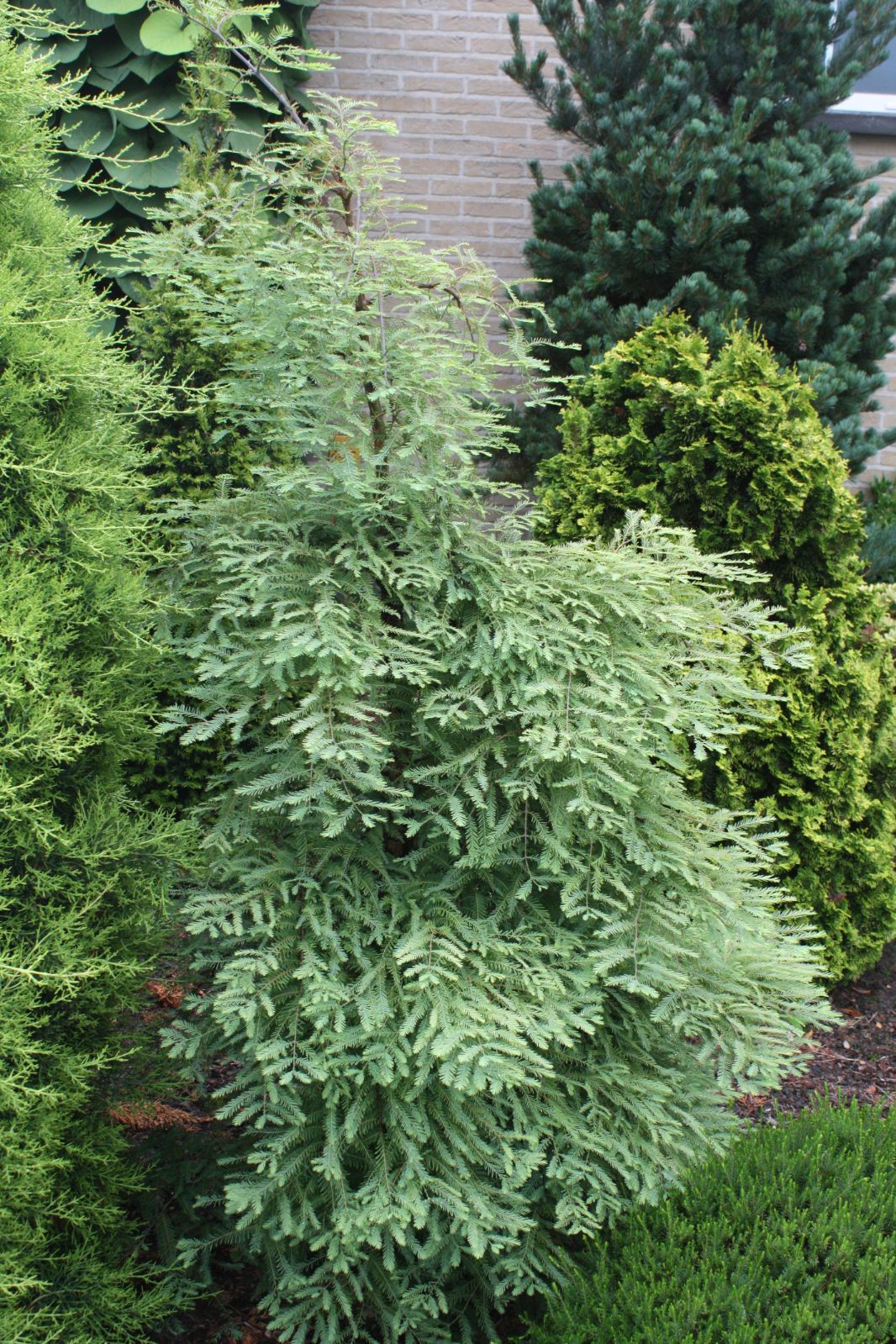Metasequoia glyptostroboides
Sponsor
Kindly sponsored by
Bluebell Arboretum
Credits
Tom Christian (2021)
Recommended citation
Christian, T. (2021), 'Metasequoia glyptostroboides' from the website Trees and Shrubs Online (treesandshrubsonline.
Genus
Common Names
- Dawn Redwood
- Water Fir
- shui shan
Synonyms
- Metasequoia glyptostroboides var. caespitosa Y.H. Long & Y. Wu
- Metasequoia neopangea Silba
- Metasequoia honshuenensis Silba & Callahan
Infraspecifics
- 'All Bronze'
- 'Bonsai'
- 'Emerald Feathers'
- GOLD RUSH
- 'Golden Dawn'
- 'Golden Guusje'
- 'Golden Oji'
- 'Green Mantle'
- 'Hamlet's Broom'
- 'Jack Frost'
- 'Little Creamy'
- 'Little Giant'
- 'Matthaei'
- 'Miss Grace'
- 'Moerheim'
- 'National'
- 'Nitschke Cream'
- 'Royal Air'
- 'Rutgers Select'
- 'Schirrmann's Nordlicht'
- 'Sheridan Spire'
- 'Snow Flurry'
- 'Vada'
- 'Waasland'
- 'White Spot'
Other taxa in genus
Tree to 50 m tall; trunk variably flared and fluted at base, to 2.5 m dbh. Bark of young trees pale orange-brown, occasionally darker in whole or in sections, irregularly exfoliating in fibrous strips; in old trees brownish-grey. Crown of young trees conical-pyramidal, broad-conical later. First order branches long, ascending or nearly level, second order brances slender. Lateral branchlets opposite, deciduous, nodding or pendent, pinkish-green in active growth, soon maturing to bronzey-brown and then brownish-grey, resembling compound leaves, ovate-elliptic in outline 3–7 × 1.5–4 cm. Leaves linear with an obtuse apex, 0.8–1.5 cm × 1.2–2 mm on old trees, larger on vigorous young trees, bluish- or greyish- or yellowish-green, turning bronzey yellow or more often orange or rust-red in autumn. Pollen cones ovoid, 2.5–5.5 × 2–3.8 mm; bracts triangular-ovate or obovate, c. 4 × 3 mm, lowest minutely ciliate distally, others glabrous. Seed cones terminal on leafy shoots 2–4(–8) cm long, purplish black when young, oblong-ellipsoid to 9 × 5.5 mm at pollination; subglobose to 1.4–2.5 × 1.6–2.3 cm when mature with 8–12 opposite scale pairs. Seeds c. 5 × 4 mm. Pollination Feb-Mar, before leaves, seed maturity Oct-Nov (China); seed cones maturing within one year. (Fu, Yu & Mill 1999; Debreczy & Rácz 2011; Farjon 2005).
Distribution China Hubei, Hunan, Sichuan
Habitat A riparian species occuring on moist valley floors, or in deep ravines and other areas with seepage and hence constant moisture, 750–1500 m asl. The majority of the natural habitat has been heavily modified in the last c. 70 years, especially on valley-floor sites, but fragments of native forest suggest that previously the wider forest featured multiple species of Quercus, Lindera, Prunus, Acer and Ilex, among others. Associates that continue to grow with Metasequoia in its moist microhabitats include species that can tolerate periodic flooding such as Liquidambar acalycina, Nyssa sinensis, and Pterocarya hupehensis.
USDA Hardiness Zone 5-10
RHS Hardiness Rating H6
Conservation status Endangered (EN)
Taxonomic note Two synonyms have been treated here: M. glyptostroboides var. caespitosa Y.H. Long & Y. Wu described from Chinese material in 1984; M. neopangea Silba described from material cultivated in the USA in 2001. In 2010 Silba resvied both names to subspecies rank. Neither name is accepted at any rank by major treatments, including the Flora of China, Plants of the World Online, Farjon 2017, etc. As with any species, seed-raised plants growing across such a vast range of climatic zones as M. glyptostroboides will show variation, but in a case such as this it is neither helpful nor prudent to attempt to classify this variation too finely, and we follow others in consigning these names to synonymy.
Metasequoia belongs to an elite group of plants – mostly quite unrelated – whose stories are the apogee of botanical legend. Its improbable discovery in China in the 1940s is one of botany’s most romantic sagas, a romance that is only accentuated by this tree’s very special beauty. Dawn Redwood (or Water Fir – a direct translation from the Chinese shui shan) belongs to that rarefied group of deciduous conifers, so that in the winter months its cinnamon-coloured bark and often exaggeratedly fluted bole may be appreciated, but it is during the summer months that this tree is at its finest, when the branchlets bear a density of incredibly delicate, fine, ferny leaves of pale emerald green. In autumn these transition through foxy shades of gold and bronze before falling.
It was these qualities, of pedigree and aesthetics, together with a fast and efficient (if slightly chaotic) distribution of seed throughout the world, and a remarkably adaptable nature, that caused Metasequoia to become one of the most familiar ‘unusual’ trees across our area. It continues to cultivate legions of fans as new generations of gardeners and dendrologists discover it, and its sustained popularity serves as ample testament to its many qualities. A consequence of Dawn Redwood’s A-list status, however, is that its tale is one that everybody thinks they know, yet behind the oft-quoted synopsis lies a tangle of names, dates, and contradictory versions of events. At the heart of this tale two events happened in quick succession; both were remarkable but their close synchronicity made them extraordinary, even more so as World War II was raging as the story unfurled.
Millions of years earlier some coniferous trees, growing in a far warmer world than we know today, shed various leaves, shoots, and cones that would, eons later, find themselves as fossils laid out on the desk of Japanese palaeobotanist Shigeru Miki. Miki realised these fossils belonged to a hitherto unnamed genus – long extinct, so he thought – and in 1941 he described Metasequoia to accommodate them. His name (literally ‘like a Sequoia’) references the considerable likeness to these trees’ evergreen cousin, Sequoia, the Coast Redwood (Farjon 2005).
Later that same year a Chinese forester named Toh Kan encountered an unfamiliar tree in Moudao (Modaoxi, Moutao, Moutaoxi) in remote Lichuan County, Hubei. He took a specimen of the bare winter twigs but did not preserve it properly nor attempt to identify it (Ma 2002). This encounter may have been the source of rumours of an unfamiliar tree that forester Zhan Wang later went to investigate, in 1943. Wang found the isolated specimen in question and mistakenly took it to be Glyptostrobus pensilis, a deciduous conifer once widespread in southern China (Ma 2002). He did not realise it at the time, but within a few years the discovery would be heralded around the world as a ‘living fossil’: Wang had discovered living trees of Miki’s fossil genus. Thus within 18 months Metasequoia had been both recognised and resurrected.
The chaos enveloping the world at that time meant it would be several years until Wang’s discovery was properly identified, and several more until it was formally named. Finally, in 1948, Hu & Cheng published their tongue-twister binomial, the mastering of which has become a rite of passage for every student of temperate horticulture: Metasequoia glyptostroboides.
Pre-empting the discovery of Wollemi Pine – another living fossil – by about half a century, the interest in Dawn Redwood was intense. The tree and its story caught the attention of the world’s popular and scientific press, and thanks to significant seed introductions it quickly became widely grown across the temperate world.
This much is well known, but the finer details of Dawn Redwood’s discovery, identification, and introduction, have long been marred by inconsistency. Intense interest in the new discovery, and the diverse, international cast of persons involved, made it inevitable that the story would be told many times over, with each version reflecting a particular point of view; it was not that any of these versions were incorrect per se, but they were incomplete. Such pieces of the puzzle were often repeated as whole truths, and with the passage of time have developed into conventional wisdom (Ma 2002).
Perhaps the commonest story is that Dawn Redwood was introduced to the west via the Arnold Arboretum, which received seed from China and then disseminated it among worthy collections around the world. It is certainly true that the Arnold Arboretum played a key role in the introduction of Dawn Redwood, and its generous distribution of seed is a key piece of history that must not be forgotten, but this is far from the whole story, for Chinese scientists themselves directly dispatched seed to botanical institutions around the world.
The story had become so muddled that by the late 20th century it attracted the interest of Jinshuang Ma of Brooklyn Botanic Garden. Following years of research, including unparalleled access to archive material and interviews with witnesses, Ma published two papers (Ma 2002; Ma 2003). In the first, he untangles the various threads of history, providing evidence for and against different versions of events; in the second, he presents a chronology of the Dawn Redwood in its first sixty years (i.e. 1943–2003). Both papers are freely available online and are commended to those who seek a meticulous chronological account, but in the interests of brevity we must here distil from them only the key events in this enigmatic tree’s recent history.
As previously touched on, when Zhan Wang collected the first specimens of extant Metasequoia in late 1943 he did not realise their significance, identifying the tree as Glyptostrobus pensilis. Wang’s specimens eventually made their way to the botanist W.C. Cheng, at the National Central University in Nanjing, and it was he who realised Wang’s identification was incorrect. Cheng dispatched one of his students to make further collections in spring 1946 and based on these concluded that the tree must be new to science, an opinion shared by Cheng’s colleague H.H. Hu. It was Hu who made the crucial link with Shigeru Miki’s fossil genus Metasequoia, paving the way for the formal publication of M. glyptostroboides in 1948, a so-called ‘living fossil’ (Ma 2002; Ma 2003). Even prior to 1948, as news of the discovery began to seep through the international botanical community the ‘living fossil’ excited interest. Professional and amateur botanists and dendrologists alike wanted it for their collections, and arrangements to secure a supply of seed were made even before the new tree had been formally described to science.
The first seed collections of M. glyptostroboides were made in 1947. These were commissioned by W.C. Cheng, supported by the simultaneous financial contributions made by Ralph Works Chaney of the University of California Berkeley, and Elmer Drew Merrill of the Arnold Arboretum, who respectively sent Cheng $25 and $250 for the purpose in June and July 1947. Cheng naturally pooled the cash and dispatched his graduate student C.T. Hwa to make collections that autumn. Hwa flew from Nanjing to Chongqing and then travelled onward by boat and on foot, eventually reaching Moudao on 12th September 1947. Over several weeks he made extensive seed collections amounting to several kilograms of seed, both from the ‘original’ isolated tree growing in the village, but mostly from a population he discovered nearby in an area since known as ‘Metasequoia valley’ (Ma 2003). He also collected seed of Taiwania cryptomerioides, which became the first introduction of the species from mainland China (Grimshaw 2011).
From this major gathering seed consignments were dispatched, not in one go but in several lots, during late 1947 and early 1948 to the Arnold Arboretum, as widely cited, but also directly to other Chinese institutions and to major foreign collections including the Royal Botanic Gardens at Kew and Edinburgh in the UK, to Missouri Botanical Garden in the US, and to botanic gardens, national arboreta and forestry agencies in countries including Denmark, the Netherlands, France, India, Australia and New Zealand (Ma 2003), many of which would have subdivided their shares yet again. The Arnold Arboretum famously subdivided its own share; Merrill sent on hundreds of packets of seed to 76 correspondents in institutions and private gardens throughout North America and Europe in March 1948, and further packets followed later (Ma 2003). It is not clear whether Merrill knew of the scale of direct distribution from China to other nations and institutions, nor whether he was aware that the first seed to arrive in a foreign country was probably that which arrived at the University of Copenhagen in Denmark and the Hortus Botanicus of Amsterdam in the Netherlands in late 1947, a few weeks before the first seed arrived in the US (Satoh 1998). Indeed, a letter in the archives at Birr Castle, Ireland, sent to the Earl of Rosse from China by Professor Hu in January 1948 included a small quantity of seed, which Professor Hu intimated may be the first to arrive in Europe (Ma 2003), suggesting that there was confusion even in China over who was sending what to whom, where and when.
In spring 1948 Ralph Chaney himself left San Francisco to visit China, determined to see the habitat of the new tree and to make his own investigations. He travelled in the company of Milton Silverman, science correspondent for the San Francisco Chronicle, whose account of the expedition would be serialised in the US on their return and which captured the attention of the American public; the story even made its way into the high echelons of early television news, including as it did tales of arduous journeys and near-death experiences (Rubin 2016). Chaney returned to the US with yet further seed from Hwa’s gathering of the previous autumn (as he visited in spring he found no ripe seed) which he distributed among collections on the US west coast, but controversy followed in his wake.
The vagaries of popular journalism are now universally accepted and entire departments employed to manage communications and public relations, but in 1948 a newspaper editor, concerned no doubt with sales, somewhat over-egged Chaney and Silverman’s role in the discovery and introduction of the tree to the US, and this seriously offended Merrill. Indeed, it spawned a ‘ridiculously petty…seven-year transcontinental barrage of misunderstandings, denunciations, attacks, vilification, innuendos, libel, slander, and outright lies’ (Silverman in Rubin 2016).
It is a curious quirk of history that early controversy over the introduction of Metasequoia to the US was mirrored by controversy in China over who was really responsible for the various elements of the discovery. Thanks to the meticulous and persistent efforts of Jinshuang Ma we now know that a whole sequence of people, from humble foresters to prestigious academics, each played their own crucial part in the tale, but controversy over the subject persisted in China well into the 21st century and the contributions of some less distinguished participants have not always received due credit.
Returning to the question of its introduction – and placing delicate egos, sensationalist editors, and honest mistakes aside – it was the unplanned, uncoordinated, and vast distribution of seed that established Metasequoia in cultivation so firmly and so quickly. It is not surprising that this labyrinthine global distribution caused many to believe that multiple seed collection events took place, but so far as anyone has ever been able to prove, all the mystifying entanglement of early introductions are ultimately traceable to C.T. Hwa’s enormous 1947 gathering (Ma 2003; Hendricks & Søndergaard 1998). This may even be the source of later introductions that, taken at face value, seem genuinely independent. For example, three trees growing at the University of Cambridge Botanic Garden, UK, were raised from seed sent directly from China by one Dr Silow. These seem to have arrived before any other consignments from China or from the Arnold Arboretum, and germinated in 1949 (botanic.cam.ac.uk). Be that as it may, Silow worked for the British Council in Beijing and is not likely to have visited the tree’s natural habitat himself; to have been able to send seed so promptly in 1948 he can only have been gifted seed from Hwa’s gathering. Clearly the intense interest in the tree created enormous demand, and while it seems probable that further seed would have been collected in 1948 and perhaps in later years, too, evidence for this is lacking, and in the absence of written evidence linking older trees to independent collecting events (and not merely a unique source) Hwa’s 1947 gathering remains the most likely source.
It is also important to bear in mind the cessation of scientific and cultural exchange between China and the west which began in 1949 and which would last for the next thirty years, meaning that no further seed introductions of Metasequoia reached the west until 1979, when a fresh consignment was sent to Hørsholm, Denmark (Hendricks & Søndergaard 1998). A significant gap in western understanding, however, is the extent to which introductions from communist China continued to be made after 1949 to sympathetic regimes, particularly in eastern Europe, though if any such introductions did occur they have passed without obvious record. Fortunately, in western Europe and North America, it was soon found that young trees of Dawn Redwood could be vegetatively propagated both by semi-ripe and hardwood cuttings, taken in late summer and early spring respectively, and nurseries quickly multiplied stock to take advantage of the sustained public interest in the new tree.
A consequence of this is that while the first wave of many thousands of trees planted in the west were genetically distinct, hundreds of thousands more planted over the next c. 30 years were clonal (Mitchell 1996). The seed packets criss-crossing the globe in 1948 gave very good germination rates indeed, and young growth tended to be strong, with variation more obvious between different climatic zones than between individual trees in the same location (Kuser 1998). Metasequoia quickly showed itself to be tougher than many had expected: remarkably cold-hardy, original trees grew well in areas of the UK that would be too cold for the related Swamp Cypress (Taxodium, another genus of deciduous conifer, but inclined to shed its leaves much later than Metasequoia), but like the Swamp Cypresses, Metasequoia excels itself in those areas that receive meaningful summer heat whilst still having constant access to plentiful moisture (Kuser 1998; Mitchell 1996). After more than 70 years in cultivation the ‘best’ trees in the UK are doubtless those growing in warmer areas with a high water table, such as those at Cambridge Botanic Garden, or those planted beside lakes in several London parks and in similar positions across the southeast of England (pers. obs.). While it needs moist soils to thrive, it will not tolerate anaerobic conditions for very long. Students of horticulture from northern Britain, however, would be forgiven for not immediately recognising a ‘southern’ Metasequoia, for the form of trees growing in hot summer areas is remarkably different from those growing in cool summer ones. The bonus of summer heat endows this tree with phenomenal vigour, and even the oldest trees in the southeast of England usually retain a shapely, symmetrical-conical crown. Trees growing in colder regions cannot match their southern counterparts in vigour (the same is true of trees in cold vs. warm regions across our area) nor are they usually symmetrical; ‘wizened’ is perhaps the best adjective, and several peculiar features of Metasequoia conspire to make many trees look older than they really are, but in this way these ‘slow grown’ trees take on a magical quality.
The cinnamon-coloured bark is an attractive feature, helping to extend interest through the winter months when the tree is bare of leaves, but the bole is often so heavily fluted and gnarled, full of irregular fissures and pockets of varying depth and darkness, that in a naturalistic woodland setting these trees can seem like portals to the underworlds. This is certainly true of an extraordinary tree growing at Cluny House Gardens in Perthshire, Scotland. An original, it was given by Alf Evans of the Royal Botanic Garden in Edinburgh in the early 1950s and planted on a steep, moist hillside in this wild, woodland garden. Just off the lowest path on the slope nearby shrubs hide it from view as one approaches, and the first, sudden glimpse of its bulging bole – especially in summer when the tree is adorned with its delicate, pale green foliage – leaves you convinced that Pan and his flute vacated the scene moments before, aided by conspiratorial song birds which have been known to nest in the deepest fissures on the trunk (pers. obs.; J. Mattingley pers. comm. 2021).
The Cluny tree’s extraordinary presence is not one that can be measured with tape measures or clinometers; it is thoroughly average in size. More serious dendrologists, in search of more serious trees, should look to the south of England (or better still, overseas) where there are 12 trees on record as of June 2021 exceeding 30 m tall, in locations from London west to Devon. The tallest, planted in 1965 and 36.5 m in 2017, grows in woodland conditions at Dunster, Somerset (Tree Register 2021). The largest girths known in the UK and Ireland belong to two trees in college gardens in Cambridge: 24.5 m × 1.68 m dbh in 2019 at Clare College; 26.5 × 1.55 m dbh in 2019 at Emmanuel College, both with heavily fluted boles (Tree Register 2021). Various theories abound as to what influences the degree of fluting in the boles – availability of water, slope, whether or not the lower branches are retained, and the density of planting all seem to contribute to varying degrees.
In North America the species has grown exceptionally well; there are outstanding examples in many areas with quite different climatic conditions, from USDA zones 5 to 10, indicative of an extraordinary tolerance for temperature so long as summer heat and year-round moisture are guaranteed (Kuser 1998). In such situations, Metasequoia continues to put on extraordinary rates of growth well after most other conifers have dramatically slowed down – only the related genera Sequoia and Sequoiadendron are comparable in such a sustained, high rate of growth (Mitchell 1996). Among the many outstanding trees in North America two growing in Longwood Gardens, Kennett Square, Pennsylvania, have excelled: one c. 30 m × 1.84 m dbh; and the other 41.5 m × 1.26 m dbh. Respectively these are the tallest and largest cultivated trees recorded by the website monumentaltrees.com as of June 2021, though it seems probable that even larger examples are in existence somewhere. In Europe several very tall trees, including one of 39.2 m in 2013, grow in Exotenwald, Weinheim, Germany, while two trees in the Netherlands have exceeded 35 m, but as yet there are no records of European trees exceeding 40 m (monumentaltrees.com).
In China – where the species can reach 50 m in appropriate habitat (Debreczy & Rácz 2011) – Metasequoia has been planted both for timber and for ornament, and its prevalence along highways and city streets suggests a high tolerance of air pollution. One such planting, in Pizhou, Jiangsu, is 30 miles in length and involves many thousands of trees, certainly the longest Metasequoia avenue in existence and perhaps the longest of any tree species. More modest avenues exist in many locations; perhaps the best in Europe is also the oldest, an allée of remarkably uniform trees on Mainau island on the German part of Lake Constance (Satoh 1998). Metasequoia has has long been used as a street tree in appropriate areas of North America – indeed, it is teetering on the brink of ubiquity in some parts of the US – but the UK seems to have been slow to embrace it in this regard; it is only in the last c. 30 years that Metasequoia has gradually become more widely used in this way, but during this time it has become a firm favourite, especially in towns and cities in southern Britain. Some of the best examples of urban plantings may be found in London, including a remarkable grove of dozens of trees around Canary Wharf underground station (Wood 2017).
The cultivated population of Metasequoia was supplemented by the introduction of new genotypes in 1979, when seed was sent to Hørsholm in Denmark. Seed from the Sichuan (Chongqing Municipality) populations was distributed by the Chinese Academy of Forestry in 1988, including to Keith Rushforth in the UK; trees from this introduction are at the Yorkshire Arboretum, at least (J. Grimshaw pers. comm. 2021). The Sino-American Botanical Expedition visited the area of natural distribution of Metasequoia in Hubei during 1980 and spent three days there but it seems that no seed was collected at this time (Hendricks & Søndergaard 1998). The next seed to reach the US seems to be that which arrived in the early 1990s, when a consortium of US institutions including Rutgers University and the Dawes Arboretum secured a fresh supply from China (Payton 2010).
By this time, Dawn Redwood’s status as a threatened species had been aptly highlighted, and modern introductions have been subject to far more rigorous record keeping than the original collections distributed at the end of the 1940s. Nevertheless, it remains the case that many thousands of genotypes will persist in the cultivated population of original trees, and the usefulness of this untapped, unexplored resource may increase in the future as the species’ natural habitat continues to decline in quality and extent (Farjon 2019). The most up-to-date conservation assessment for this species, published on the website Threatened Conifers of the World, paints a bleak picture. For many decades, perhaps centuries before its discovery, the natural habitat of Metasequoia has been subject to intense reduction as the largest tracts of riparian forest in the valley bottoms were cleared for agriculture. By the early 21st century the total wild population is estimated to be a little over 5000 mature trees, here taken to mean with a dbh greater than 20 cm. Nearly all of these occur in Lichuan, Hubei, where the species was first discovered; a handful of others occur in Longshan (Hunan) and in Chongqing (Sichuan). All mature trees are now protected, but it is not always obvious which of these are remnants of the cleared forest, which may have regenerated since, and which are planted, for local people were propagating and planting Metasequoia for various purposes well before its ‘discovery’. The change in land use that continues to affect the majority of its former habitat means that there is little chance of natural regeneration; habitat-scale conservation measures remain inadequate, and in his conservation assessment Aljos Farjon cautions ‘the survival of this very interesting species in its natural habitat is not guaranteed’ (Farjon 2019).
Various accounts of Metasequoia’s natural habitat chart a parallel decline in the diversity of its associates. A particularly interesting paper (Chu & Cooper 1998) published in Arnoldia 58 (4) gives an overview of the cultural history of the valley that still contains the bulk of the global population of wild trees, and reports on associated species that were still relatively common in the late 1940s. These include several species that were particularly frequent, including Cunninghamia lanceolata, Castanea seguinii, Liquidambar acalycina, Rhus spp., and Lindera glauca, and several more which, although far less frequent, are well known to gardeners in the west, including: Acer davidii, Styrax japonicus, Idesia polycarpa, Populus adenopoda, Nyssa sinensis, Kalopanax septemlobus, Cyclocarya paliurus, Cercidiphyllum japonicum, Betula luminifera and Carpinus fargesii, Cephalotaxus fortunei, Fagus sinensis, Quercus acutissima, Sassafras tsumu, Tapiscia sinensis, and Ulmus multinervis (Chu & Cooper 1998).
Not surprisingly, perhaps, for a tree grown so extensively from seed, variation has shown up in seed beds around the world, and some cultivars have become widely grown. A collaboration between Rutgers University and Princeton Nurseries, both of New Jersey, USA, has seen several new cultivars selected in recent years, but many remain confined to relatively limited circulation in North America. In their seminal work on conifer cultivars the late Aris Auders and the late Derek Spicer list 31 Dawn Redwood cultivars (Auders & Spicer 2012) but then as now only a few are widely available on both sides of the Atlantic. Several seem rather like one another, and especially with some of the more recent introductions it may be the case that distinctive characters obvious in youth become increasingly subtle with age. The most important selections continue to be the yellow-leaved GOLD RUSH (listed here under its official cultivar name ‘Golden Oji’) , ‘National’ selected for its narrow crown, and ‘Emerald Feathers’ for the rich green colour of its foliage.
Named clones must, of course, be propagated vegetatively. Hardwood cuttings of c. 15 cm, cut in late winter or early spring beneath a pair of buds and treated with rooting hormone then sunk into sand and kept moist, ideally with gentle bottom heat, should root readily. Softwood cuttings may be taken in late summer, treated with hormone, and rooted in any good cutting media over bottom heat and under mist (Kuser 1998). In areas with reliably hot summers Metasequoia can produce viable seed when multiple trees are grown in close proximity, and a ready supply continues to be available to nurseries the world over via networks of seed merchants.
Perhaps the most remarkable thing that can be said about this ancient, enigmatic tree is that its story continues to resonate so many decades after its discovery. At times, those of us who are familiar with it are, perhaps, in danger of taking it for granted, but on telling its story to a dendrological neophyte we are reminded just what an unlikely and extraordinary tree this is. That it now graces gardens, parks, streets and cities all across the world is an astonishing feat of resilience and of horticultural accomplishment; a pertinent reminder of the essential role of horticulture in plant conservation.
'All Bronze'
A Dutch cultivar raised by the Nelis Kools Nursery c. 2000, ‘All Bronze’ has young foliage described as flushing with a bronze hue, and intense orange-bronze autumn colour. The bark is also reported to be a darker colour than normal, while the habit is somewhat upright, and the vigour typical (Auders & Spicer 2012).
'Bonsai'
Described by Auders & Spicer (2012) as a dwarf form, this plant is much reduced in vigour compared to typical forms of the species, but the cultivar name ‘Bonsai’ could be construed as misleading as the plant is still capable of growing to 1 m in ten years and its ultimate height remains uncertain. It was raised at Rutgers University, New Jersey, from a new introduction of Chinese seed and selected by Dr John Kuser in 1992. Besides its ‘dwarf’ habit, the foliage is described as somewhat glaucous green, held on pendent branchlets.
'Emerald Feathers'
One of the best known Dawn Redwood cultivars, ‘Emerald Feathers’ was selected prior to 1972 at the US National Arboretum in Washington DC, hence it is traceable to the original introduction of 1948. It was selected for the combination of its slender conical habit, more lustrous green leaves than is typical, and its extraordinary vigour, being capable of achieving 7 m in ten years though 4–6 m is more usual (Auders & Spicer 2012). It is possible that the character of lustrous green leaves is somewhat variable, perhaps on accout of some environmental factor: a tree at the Savill Garden, UK, was not obviously greener than any other when seen in May 2021 (pers. obs.).
GOLD RUSH
See ‘Golden Oji’
'Golden Dawn'
A miniature selection of much reduced vigour, forming a rather squat globose plant to c. 1.5 m in ten years. The foliage is described as smaller than typical, creamy-yellow at first, darkening to golden yellow as it matures. It was raised from seed by K.W. Murray in Delaware, c. 1986, and seems still to be restricted to cultivation in North America (Auders & Spicer 2012).
'Golden Guusje'
Presumably a full-size tree in time, ‘Golden Guusje’ was selected in the Netherlands by Nelis Kools in 2000. It distinguishes itself in its golden-yellow foliage and dark, somewhat peeling bark (Auders & Spicer 2012).
'Golden Oji'
Synonyms / alternative names
Metasequoia glyptostroboides GOLD RUSH
Metasequoia glyptostroboides GOLDEN MANTLE
Metasequoia glyptostroboides 'Ogon'
Metasequoia glyptostroboides ‘Golden Oji’ is everywhere better known by its trade designation, GOLD RUSH, usually written as though it were a normal cultivar name, which it is not. The convention on Trees and Shrubs Online is to use the recognised cultivar name for entries; the same clone can have multiple trade designations whereas the published or registered cultivar name is a fixed entity. Consequently, GOLD RUSH has to be relegated to a secondary position here, as does the original cultivar name, ‘Ogon’, which was overruled by the name ‘Golden Oji’ when this received a US Plant Patent, and which therefore takes precedence.
It was raised from irradiated seed sown at the Kameyama Breeding Station of the Institute for Forest Tree Improvement in Mie, Japan, in 1974. From here, it was introduced to North America by the Stanley & Sons Nursery of Oregon under its original Japanese name ‘Ogon’, but soon marketed it in the US as ‘Gold Rush’, from whence came later permutations of the name. It was introduced to Europe in 1993 by the Dutch nurseryman Pieter Zwijnenburg, and then in 1995 the Japanese company behind the breeding of this tree, perhaps sensing it was on the brink of stardom, applied for a US Plant Patent for it under the new name ‘Golden Oji’, which according to the International Code of Nomenclature for Cultivated Plants became the new accepted cultivar name (Auders & Spicer 2012). It seems important to relay this rather convoluted history as GOLD RUSH has since become probably the most popular Dawn Redwood cultivar on both sides of the Atlantic, bearing as it does foliage of a most intense yellow on a tree of otherwise typical character.
Sited carefully, GOLD RUSH can be an exceptionally beautiful tree. Even on a dull day its bright shining foliage can light up the dullest of corners, but like most forms of the species it is not particularly shade tolerant and is prone to rather sparse branching if grown in too shady a spot, which can dilute the intended effect of a lush, full tree. Open glades with plenty of side light are ideal, so too the edges of bodies of water which give the added benefit of its beautiful, shimmering reflection, but it does not enjoy the company of other yellow-leaved trees: the quality of GOLD RUSH’s yellow will render any other mediocre.
'Green Mantle'
Raised in the UK prior to 1990, ‘Green Mantle’ is another Dawn Redwood that has ostensibly greener leaves than typical forms of the species, but it has never achieved anything like the circulation of ‘Emerald Feathers’, which is better known for the same character (Auders & Spicer 2012).
'Hamlet's Broom'
One of very few true extreme dwarfs of this species, ‘Hamlet’s Broom’ was propagated from a witches’ broom found in Denmark prior to 2005 (Auders & Spicer 2012). It probably has a limited circulation among specialist growers.
'Jack Frost'
A rare example of a variegated Dawn Redwood, ‘Jack Frost’ was selected from a pan of seedlings by the Bucholz & Bucholz Nursery, Oregon in 1989. According to Auders & Spicer (2012) it is a vigorous cultivar with bright green leaves with a white ‘frosted’ variegation, but Payton (2010) suggests it has only ‘a hint’ of variegation.
'Little Creamy'
Found in the Netherlands in 2001, Auders & Spicer (2012) describe this selection as ‘A slow growing, tight, very upright plant with thick branches and creamy white new growth that turns into a white-green variegation.’
'Little Giant'
A relatively recent, American selection, ‘Little Giant’ was first listed by the Bucholz & Bucholz Nursery in 2009 (Auders & Spicer 2012). It is described as fast-growing with a broad pyramidal habit, presumably created by wide-spreading branches and/or a narrow spire-like crown even in youth, which is not unheard of in a sample of seed raised trees, planted out and left to express their diversity.
'Matthaei'
Synonyms / alternative names
Metasequoia glyptostroboides 'Matthaei Broom'
This unusual, dwarf cultivar was raised from a witches’ broom found in 1974 in the Matthaei Botanical Garden in Ann Arbor, Michigan. The foliage retains a bronzey hue through the growing season (Auders & Spicer 2012).
'Miss Grace'
The Hillier Manual calls this witches’ broom a ‘small, elegant cultivar’ (Edwards & Marshall 2019) and praises its compact habit and weeping branches, which bear grey-green foliage through the growing season, reliably turning brilliant orange in autumn, but Auders & Spicer (2012) caution that it must be staked. It was introduced by the Bucholz & Bucholz Nursery, Oregon, in 1998.
'Moerheim'
Auders & Spicer (2012) describe ‘Moerheim’ as a columnar tree with upright branches, but they stop short of referring to it as fastigiate. It was selected in the Netherlands from an original tree – grown from seed received from the Arnold Arboretum in 1948 – growing at the Belmonte Arboretum.
'National'
Synonyms / alternative names
Metasequoia glyptostroboides 'Fastigiata'
Despite its original, invalid name of ‘Fastigiata’, Auders & Spicer (2012) offer little commendation for ‘National’, suggesting it is ‘a compact, narrowly conical tree, otherwise similar to the species’, nor do they suggest how, if at all, it may reliably be differentiated from other narrowly conical forms, for example ‘Moerheim’. Nevertheless, its distinct origin is a point of interest: it was selected from an original tree growing in the US National Arboretum in 1958, a mere ten years after the species’ introduction, suggesting that its distinctiveness may be most apparent in youth, becoming somewhat reduced with advancing age.
'Nitschke Cream'
This cultivar combines several unusual traits, including an upright habit, leaves which emerge cream but later turn green, and very dark bark, described as ‘black’ by Auders & Spicer (2012). It was selected in Australia before 1998.
'Royal Air'
This is a rather obscure, very recent addition to the range of Dawn Redwood cultivars available in commerce. Apparently of Dutch origin, the Blubell Arboretum & Nursery in the UK describe it as being of ‘upright, pyramidal habit growing to be a slender, small tree in time’ (bluebellnursery.com).
'Rutgers Select'
A clone selected for its exceptional vigour, growing up to 2 m per year in youth. It was selected from a new introduction of wild-collected seed by Dr John Kuser and Andrea Bonville at Rutgers University, New Jersey, in 1992 (Auders & Spicer 2012).
'Schirrmann's Nordlicht'
This selection arose as a witches’ broom on a plant of ‘White Spot’ growing in Germany, sometime prior to 2005. The foliage emerges creamy white in the spring; as it matures it turns green with a bronze variegation (Auders & Spicer 2012).
'Sheridan Spire'
While several narrowly columnar selections of Dawn Redwood exist, ‘Sheridan Spire’ sounds narrower than most. Auders & Spicer (2012) suggest it can reach 3 m height in ten years, while remaining less than 1 m in canopy spread. It was spotted in a row of cuttings at the Sheridan Nursery, Canada, in 1960.
'Snow Flurry'
Synonyms / alternative names
Metasequoia glyptostroboides 'Pat McCracken'
Metasequoia glyptostroboides 'McCracken's White'
Introduced to cultivation by Pat McCracken from North Carolina in 2005, ‘Snow Flurry’ forms an upright tree whose foliage is cream-white variegated. It was introduced to European cultivation by the Edwin Smits Nursery in the Netherlands in 2009 (Auders & Spicer 2012).
'Vada'
Grown from seed received from the Arnold Arboretum in 1949 and selected in Europe before 1970, ‘Vada’ was named by Broekhuizen & Zwart in the Netherlands, distinguished by its preponderance of horizontal branches, creating a strongly pyramidal profile (Auders & Spicer 2012).
'Waasland'
Selected at the eponymous Belgian arboretum in the late 1970s, this cultivar has a very upright growth habit, with the branches and even the branchlets all described as erect (Auders & Spicer 2012 – but again, those authors tellingly resist the temptation to call this cultivar fastigiate). The bark is further described as dark brown to black.
'White Spot'
While most variegated Dawn Redwood cultivars have a narrow margin of variegation around the perimeter of their leaflets, ‘White Spot’ leaves are additionally speckled with an irregular variegation over other parts of the leaf surface, across the entire plant. It was found in the Netherlands in the early 1980s and later put into commerce by Pieter Zwijnenburg in the late 1990s (Auders & Spicer 2012). A witches’ broom found on ‘White Spot’ resulted in the cultivar ‘Schirrmann’s Nordlicht’.

